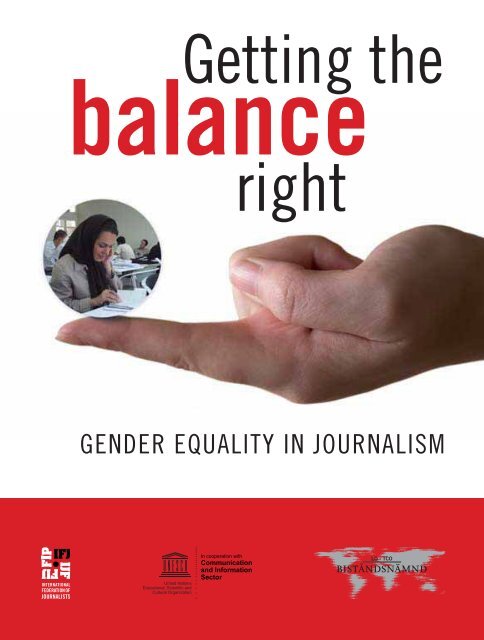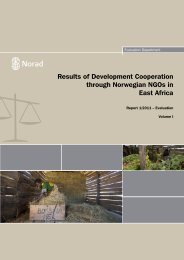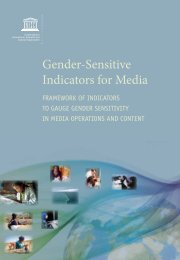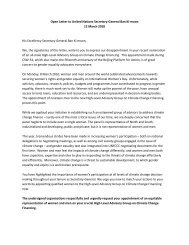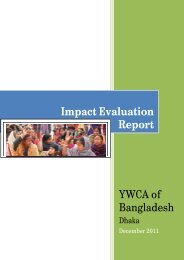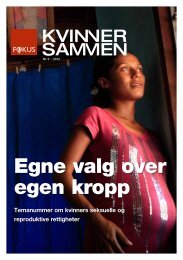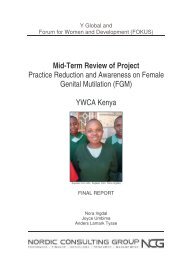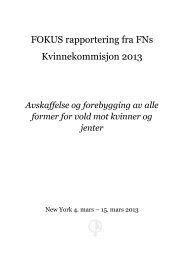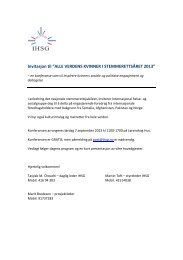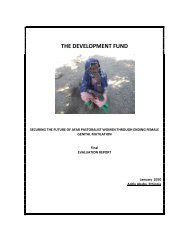Getting the balance right: gender equality in journalism; 2009 - Fokus
Getting the balance right: gender equality in journalism; 2009 - Fokus
Getting the balance right: gender equality in journalism; 2009 - Fokus
Create successful ePaper yourself
Turn your PDF publications into a flip-book with our unique Google optimized e-Paper software.
Publisher <strong>in</strong>formation: International Federation of Journalists, RésidencePalace, rue de la loi 155, 1040 Brussels, BelgiumCopy<strong>right</strong>: No part of this publication may be reproduced <strong>in</strong> any formwithout <strong>the</strong> written permission of <strong>the</strong> publisher. The contents of thispublication are copy<strong>right</strong>ed and <strong>the</strong> <strong>right</strong>s to use of contributions rest with<strong>the</strong> authors <strong>the</strong>mselves. All <strong>right</strong>s reservedISBN: 9789490116002The author is responsible for <strong>the</strong> choice and presentation of <strong>the</strong> factsconta<strong>in</strong>ed <strong>in</strong> this book and for <strong>the</strong> op<strong>in</strong>ions expressed, which are notnecessarily those of UNESCO and LO.TCO, and do not commit <strong>the</strong>organisations. The designations employed and <strong>the</strong> presentation ofmaterial throughout <strong>the</strong> publication do not imply <strong>the</strong> expression of anyop<strong>in</strong>ion whatsoever on <strong>the</strong> part of UNESCO and LO.TCO concern<strong>in</strong>g <strong>the</strong>legal status of any country, territory, city or area or of its authorities, orconcern<strong>in</strong>g <strong>the</strong> delimitation of its frontiers or boundaries.Design: Mary Schrider, mary@hazards.orgPr<strong>in</strong>ted by Druk. Hoeilaart, BelgiumCover image: Reporter Nafiseh Majidizadeh, Editor of News Page, Iran.© Asa’ad NafgshbandiPublished <strong>in</strong> Belgium by <strong>the</strong> International Federation of Journalists© <strong>2009</strong> International Federation of JournalistsInternational Press Centre Residence Palace, Block C155 rue de la Loi B - 1040 Brussels Belgium
CONTENTSFOREWORD ....................................................................................................iiPREFACE ......................................................................................................ivINTRODUCTION ..............................................................................................1PART I: Women journalists <strong>in</strong> <strong>the</strong> media ........................................................3PART II: Stereotypes <strong>in</strong> <strong>the</strong> Media ................................................................13PART III: Women <strong>in</strong> <strong>the</strong> unions and associations .........................................21PART IV: Resources and Contacts................................................................33ANNEXE A: IFJ Ethics of bully<strong>in</strong>g ..................................................................41ANNEXE B: IFJ Gender Policies passed at Congress .....................................46
FOREWORDThe designation of <strong>gender</strong> <strong>equality</strong> as one of two global prioritiesof <strong>the</strong> Organization <strong>in</strong> its Medium-Term Strategy for 2008-2013 has placed this critical objective on <strong>the</strong> forefront ofUNESCO’s strategic focus. This priority will be pursued througha two-pronged approach: (i) <strong>gender</strong>-specific programm<strong>in</strong>g and(ii) <strong>gender</strong> ma<strong>in</strong>stream<strong>in</strong>g with action <strong>in</strong> all of UNESCO’s fields ofcompetence: education, <strong>the</strong> sciences, culture, and communicationand <strong>in</strong>formation and will apply to all levels of <strong>in</strong>terventions frompolicy development, awareness rais<strong>in</strong>g and advocacy, research, to<strong>in</strong>stitutional capacity build<strong>in</strong>g and tra<strong>in</strong><strong>in</strong>g.As a contribution to this strategic commitment UNESCO hasdeveloped a companion document to <strong>the</strong> Medium-Term Strategyentitled <strong>the</strong> UNESCO Priority Gender Equality Action Plan 2008-2013, which provides a road map to translate <strong>the</strong> ideals of UNESCOregard<strong>in</strong>g <strong>the</strong> pursuit of <strong>gender</strong> <strong>equality</strong> <strong>in</strong>to a practical and resultsbasedactivity for <strong>the</strong> 6 years covered by <strong>the</strong> medium-term strategy.UNESCO believes that all forms of discrim<strong>in</strong>ation on <strong>the</strong> basisof <strong>gender</strong> are violations of human <strong>right</strong>s, and a significant barrierto peace, susta<strong>in</strong>able development and <strong>the</strong> achievement of all<strong>in</strong>ternationally recognized development goals.We are m<strong>in</strong>dful of <strong>the</strong> Beij<strong>in</strong>g Declaration and Platform for Actionadopted unanimously at <strong>the</strong> United Nations Fourth World Conferenceon Women (4-15 September 1995). Among many o<strong>the</strong>r critical areasof concern, <strong>the</strong> Declaration clearly recognized <strong>the</strong> potential of <strong>the</strong>media to make a greater contribution to <strong>the</strong> advancement of women.It called on governments and <strong>in</strong>ternational development organisationsto take action to address “stereotyp<strong>in</strong>g of women and <strong>in</strong><strong>equality</strong> <strong>in</strong>women’s access to and participation <strong>in</strong> all communication systems,especially <strong>in</strong> <strong>the</strong> media”.IIGENDER EQUALITY IN JOURNALISM
This handbook, “<strong>Gett<strong>in</strong>g</strong> <strong>the</strong> Right Balance”, is a timely,illustrated and easy-to-read guide and resource material forjournalists. The handbook evolved primarily out of a desire toequip all journalists with more <strong>in</strong>formation and understand<strong>in</strong>g of<strong>gender</strong> issues <strong>in</strong> <strong>the</strong>ir work. It is addressed to media organisations,professional associations and journalists’ unions seek<strong>in</strong>g to contributeto <strong>the</strong> goal of <strong>gender</strong> <strong>equality</strong>.UNESCO, jo<strong>in</strong>tly with its partners, <strong>in</strong>vites journalists to use thishandbook to become better <strong>in</strong>formed when deal<strong>in</strong>g with <strong>gender</strong>issues <strong>in</strong> <strong>the</strong> media sphere. It will assist people work<strong>in</strong>g <strong>in</strong> <strong>the</strong>media to assess progress on <strong>gender</strong> <strong>equality</strong>, identify challenges,and contribute to local, regional and global debates lead<strong>in</strong>g to <strong>the</strong>formulation of concrete policies to promote <strong>gender</strong> <strong>equality</strong> and <strong>the</strong>advancement of women worldwide– Abdul Waheed Khan, Assistant Director-Generalfor Communication and Information,UNESCOGENDER EQUALITY IN JOURNALISMIII
PREFACEOne of <strong>the</strong> greatest challenges fac<strong>in</strong>g journalists, both menand women, is to resist <strong>the</strong> culture of casual stereotype <strong>in</strong> oureveryday work.That is no easy task when media are full of images and clichéabout women and girls. Many are relatively harmless, but some, often<strong>the</strong> most powerful, portray women as objects of male attention -- <strong>the</strong>glamorous sex kitten, <strong>the</strong> sa<strong>in</strong>ted mo<strong>the</strong>r, <strong>the</strong> devious witch, <strong>the</strong>hard-faced corporate and political climber.In every region and culture <strong>the</strong>re are fixed images, deeplyentrenched prejudices and biased reflexes that pose challenges tojournalists and media. This booklet urges us to do more to confront<strong>the</strong>se distortions <strong>in</strong> our newsrooms and <strong>in</strong> our unions.In spite of <strong>the</strong> progress made over <strong>the</strong> last 25 years—and <strong>the</strong>reare more women <strong>in</strong> media and more female executives than everbefore—media still churn out female stereotypes that limit <strong>the</strong> powerof women <strong>in</strong> society. Accord<strong>in</strong>g to one global survey, if we cont<strong>in</strong>ueat <strong>the</strong> current rate of progress it will take ano<strong>the</strong>r 75 years to achieve<strong>gender</strong> <strong>equality</strong> <strong>in</strong> media.That is a dismal prospect given that it is more than 40 yearss<strong>in</strong>ce laws were <strong>in</strong>troduced penalis<strong>in</strong>g discrim<strong>in</strong>ation aga<strong>in</strong>st womenand provid<strong>in</strong>g for <strong>the</strong> allocation of basic political and social <strong>right</strong>s,equal pay and employment <strong>right</strong>s.But prejudices do not disappear at <strong>the</strong> dictate of lawmakers.Battles for <strong>equality</strong> are still be<strong>in</strong>g fought <strong>in</strong> every country. It takesargument, debate, tra<strong>in</strong><strong>in</strong>g and practical commitment to confrontdiscrim<strong>in</strong>ation wherever it lurks. This booklet provides help. It is auseful addition to <strong>the</strong> armoury of people with<strong>in</strong> <strong>journalism</strong> who arefight<strong>in</strong>g discrim<strong>in</strong>ation and champion<strong>in</strong>g journalistic standards.IVGENDER EQUALITY IN JOURNALISM
In many countries women are strongly represented <strong>in</strong> newsroomsbut media are still very male dom<strong>in</strong>ated when <strong>the</strong> top positions areexam<strong>in</strong>ed. Women are marg<strong>in</strong>alised <strong>in</strong> <strong>the</strong> news both <strong>in</strong> <strong>the</strong> contentof <strong>the</strong> jobs <strong>the</strong>y do and <strong>in</strong> <strong>the</strong> opportunities <strong>the</strong>y have to make <strong>the</strong>irway <strong>in</strong> <strong>the</strong> profession. They are even marg<strong>in</strong>alised <strong>in</strong> <strong>the</strong> unions thatrepresent <strong>the</strong>m.Fair <strong>gender</strong> portrayal is a professional and ethical aspiration,similar to respect for accuracy, fairness and honesty. It is <strong>the</strong> o<strong>the</strong>rside of <strong>the</strong> co<strong>in</strong> that says women need to be more present at higherlevels of <strong>the</strong> news bus<strong>in</strong>ess, both at work and <strong>in</strong> <strong>the</strong> unions. In aworld where hard news is still ma<strong>in</strong>ly reported and presented bymen journalists need to stand up for <strong>gender</strong> <strong>equality</strong>. This <strong>equality</strong>is not just a women’s’ issue; everyone benefits from elim<strong>in</strong>at<strong>in</strong>gdiscrim<strong>in</strong>ation.This booklet gives added argument and dynamism to acampaign that should be taken up <strong>in</strong> very newsroom, every mediahouse and every union meet<strong>in</strong>g. Journalism has its roots <strong>in</strong> <strong>the</strong> fightfor decency, progress and <strong>right</strong>s for all. It will honour its tradition andre<strong>in</strong>vigorate <strong>the</strong> profession when <strong>the</strong> ideas, guidel<strong>in</strong>es and advice <strong>in</strong><strong>the</strong>se pages are put <strong>in</strong>to practice.– Aidan White, IFJ General SecretaryGENDER EQUALITY IN JOURNALISMV
“[Gender <strong>equality</strong>] does not mean that women andmen have to become <strong>the</strong> same, but that <strong>the</strong>ir <strong>right</strong>s,responsibilities and opportunities will not depend onwhe<strong>the</strong>r <strong>the</strong>y are born male or female,” ABC of womenworkers’ <strong>right</strong>s and <strong>gender</strong> <strong>equality</strong>, ILO.© SARVESH
INTRODUCTIONIf media are a mirror of society as <strong>the</strong>y should be, <strong>the</strong>ycerta<strong>in</strong>ly need to reflect better <strong>the</strong> fact that <strong>gender</strong> <strong>equality</strong> is afundamental human <strong>right</strong>. It is about equal treatment of men andwomen, and encompasses issues such as equal pay for equal work,equal access to decision mak<strong>in</strong>g bodies, employment, pensions,health care, promotions, maternity and paternity leave. In <strong>journalism</strong>it also means fair <strong>gender</strong> portrayal <strong>in</strong> <strong>the</strong> news, <strong>the</strong> use of neutral andnon-<strong>gender</strong> specific language, and women not be<strong>in</strong>g pigeonholed as‘lifestyle’ or ‘soft’ news reporters.It is essential that <strong>the</strong> media promote <strong>gender</strong> <strong>equality</strong>, bothwith<strong>in</strong> <strong>the</strong> work<strong>in</strong>g environment and <strong>in</strong> <strong>the</strong> representation of women.Media should open this debate and highlight <strong>the</strong> issue <strong>in</strong> <strong>the</strong> newsagenda to better <strong>in</strong>form society and to overcome <strong>gender</strong> stereotypes.Journalists’ unions and associations have a key role to play <strong>in</strong> thiswork, not least by ensur<strong>in</strong>g that equal treatment for all media workersrema<strong>in</strong> on media’s agenda.The International Federation of Journalists (IFJ), <strong>the</strong> InternationalLabour Organisation (ILO), UNESCO and o<strong>the</strong>r United Nationsagencies all promote <strong>the</strong>se pr<strong>in</strong>ciples, yet nowhere <strong>in</strong> <strong>the</strong> world so farhas true and total <strong>gender</strong> <strong>equality</strong> been accomplished. “We still havea long way to go, says UN Secretary General Ban Ki-Moon. “Womenare still severely hampered by discrim<strong>in</strong>ation, lack of resources andeconomic opportunities, by limited access to decision-mak<strong>in</strong>g and by<strong>gender</strong>-based violence”.GENDER EQUALITY IN JOURNALISM1
Journalism is no exception. Inside media and <strong>in</strong> <strong>the</strong> work ofjournalists we see evidence of how much still needs to be done toachieve equal <strong>right</strong>s for women. This booklet provides guidel<strong>in</strong>es tojournalists and union activists on ways of br<strong>in</strong>g<strong>in</strong>g <strong>gender</strong> <strong>equality</strong><strong>in</strong>to <strong>the</strong> ma<strong>in</strong>stream of our profession.The booklet is divided <strong>in</strong>to four sections. Section One, ‘womenjournalists <strong>in</strong> <strong>the</strong> media’ sets out <strong>the</strong> current status of women mediaprofessionals, <strong>the</strong> level and areas of <strong>in</strong><strong>equality</strong> and measures that areused to address <strong>the</strong>m.Section Two ‘stereotypes <strong>in</strong> <strong>the</strong> media’ exam<strong>in</strong>es mediaperformance <strong>in</strong> portrayal of women and re<strong>in</strong>forc<strong>in</strong>g or break<strong>in</strong>gdown exist<strong>in</strong>g stereotypes and raises some of <strong>the</strong> key professionalchallenges fac<strong>in</strong>g journalists <strong>in</strong> <strong>the</strong>ir report<strong>in</strong>g.Section Three ‘women <strong>in</strong> <strong>the</strong> unions and associations’ exam<strong>in</strong>es<strong>the</strong> role unions, professional organisations and union activistscan play <strong>in</strong> promot<strong>in</strong>g <strong>equality</strong> and ensur<strong>in</strong>g women are properlyrepresented <strong>in</strong> <strong>the</strong>ir decision mak<strong>in</strong>g bodiesSection Four ‘ resources and contacts’ po<strong>in</strong>ts to <strong>the</strong> tools thatwill get <strong>the</strong> job done- <strong>the</strong> resources that tackle <strong>gender</strong> <strong>equality</strong> <strong>in</strong> <strong>the</strong>media and <strong>in</strong> <strong>the</strong> workplace, as well as a set of useful contacts whopromote women’s <strong>right</strong>s and <strong>gender</strong> <strong>equality</strong> <strong>in</strong> <strong>the</strong> media.2 GENDER EQUALITY IN JOURNALISM
PART I:Women journalists <strong>in</strong> <strong>the</strong> mediaMore women than ever are work<strong>in</strong>g <strong>in</strong> media. In somecountries like Russia and Sweden, <strong>the</strong>y form a majority of<strong>the</strong> <strong>journalism</strong> workforce. But <strong>the</strong>y do not play an equal role<strong>in</strong> <strong>the</strong> report<strong>in</strong>g process. Accord<strong>in</strong>g to <strong>the</strong> Global Media Monitor<strong>in</strong>gProject (GMMP), a global survey taken every five years s<strong>in</strong>ce 1995,by 2005 57% of all television news presenters were women, yet only29% of news items were written by female reporters.Meanwhile only 32% of “hard” news was written or covered bywomen. Women are more often found report<strong>in</strong>g on “soft” subjects, suchas social issues, <strong>the</strong> family, or arts and “liv<strong>in</strong>g” (up to 40% women).Percentage of female presenters and reporters 2000-2005 (GMMP)%605657504940454142363028292620Newspaper reporterRadio reporterTV reporterRadio presenterTV presenter1002000 2005GENDER EQUALITY IN JOURNALISM3
While statistics show that more and more women are tra<strong>in</strong><strong>in</strong>gand enter<strong>in</strong>g <strong>the</strong> field, <strong>the</strong> number of women producers, executives,chief editors, and publishers rema<strong>in</strong>s shock<strong>in</strong>gly low. In 2002 <strong>the</strong>Canadian Newspaper Association report stated that only 8% of <strong>the</strong>editors-<strong>in</strong>-chief and 12% of publishers were women. The EasternAfrica Journalists’ Association (EAJA) reported <strong>in</strong> 2008 that less than20% of editorial places were filled by women <strong>in</strong> <strong>the</strong> region.FRONTLINE REPORTING Women work<strong>in</strong>g <strong>in</strong> war zonesINSI RECOMMENDATIONS Women journalists should be encouraged to discuss <strong>the</strong>ir particular needs forsupport and protection with <strong>the</strong>ir colleagues—male AND female—and ensurethat <strong>the</strong>se are met. Colleagues and managers should be aware of <strong>the</strong> unnecessary pressure womencan experience to prove that <strong>the</strong>y are capable of do<strong>in</strong>g <strong>the</strong> job. It must be made explicitly clear to everyone that sexual harassment andun<strong>in</strong>vited sexual advances are unacceptable. Male bosses should be aware ofand acknowledge <strong>the</strong> threat and fear of rape. If work<strong>in</strong>g as an embedded reporter, don’t assume anyth<strong>in</strong>g <strong>in</strong> terms of yourpersonal safety. Do all you can to be clear <strong>in</strong> advance about <strong>the</strong> conditionsyou will face. Ask who will meet you, where you will sleep, etc, so you knowwhat to expect. If possible, women journalists should be allowed a say <strong>in</strong> who <strong>the</strong>y would like towork with <strong>in</strong> a team. Women journalists (<strong>in</strong>clud<strong>in</strong>g freelancers) should also, if possible, have <strong>the</strong>opportunity to tra<strong>in</strong> <strong>in</strong> self-defence. Hostile environment tra<strong>in</strong><strong>in</strong>g courses should di rectly address women’s needs—which will <strong>in</strong> turn help raise awareness among <strong>the</strong>ir male colleagues.4 GENDER EQUALITY IN JOURNALISM
In many countries <strong>the</strong> <strong>gender</strong> pay gap (different salaries for menand women) still exists. In most countries, <strong>the</strong> terms “sticky floors”and “glass ceil<strong>in</strong>gs” are used to describe how and why <strong>the</strong> <strong>gender</strong>pay gap <strong>in</strong>creases with age, as women are overlooked for promotion<strong>in</strong> favour of male colleagues. Family unfriendly work<strong>in</strong>g practicessuch as <strong>in</strong>flexible work<strong>in</strong>g hours or penalis<strong>in</strong>g women for tak<strong>in</strong>g timeout to raise children, all contribute to <strong>the</strong> pay gap. Women need smaller and properly-fitted body armour which <strong>the</strong>y canwear comfortably. Colleagues—male as well as female—should take <strong>the</strong> <strong>in</strong>itiative to ask women<strong>the</strong>y’re work<strong>in</strong>g with if <strong>the</strong>y need more fem<strong>in</strong><strong>in</strong>e supplies. Before any assignment, female employees and <strong>the</strong>ir managers should makesure <strong>the</strong>y know of any local customs specific to women. Female—and male—freelancers deserve <strong>the</strong> same support as <strong>the</strong>ir staffcolleagues. For men and women alike, it’s not a good idea to bottle up emotional distress.F<strong>in</strong>d someone you trust who you can talk with—male or female. Offer tolisten—without judgment—to <strong>the</strong> concerns of colleagues. Free and confidential counsell<strong>in</strong>g should be available for women—and men—who wish to use it after experienc<strong>in</strong>g conflict or o<strong>the</strong>r traumatic events. Some woman-to-woman practical advice: Carry a personal attack alarm Wear<strong>in</strong>g a wedd<strong>in</strong>g r<strong>in</strong>g can deter unwelcome attention If visit<strong>in</strong>g Muslim countries, pack a head-scarf/chador just <strong>in</strong> case Take care before go<strong>in</strong>g out with wet hair. In some cultures, this can bemis<strong>in</strong>terpreted as a sexual signal.GENDER EQUALITY IN JOURNALISM5
High stress levels, bully<strong>in</strong>g andharassment, unacceptable workloads,and anti-social work<strong>in</strong>g hours pressurework<strong>in</strong>g mo<strong>the</strong>rs <strong>in</strong>to part-time, temporaryor freelance positions. This <strong>in</strong> turn puts<strong>the</strong>m <strong>in</strong> even more vulnerable positions<strong>in</strong> terms of job security, promotions, legalstatus and ability to share <strong>the</strong> same <strong>right</strong>sas contracted colleagues.The EAJA reports that <strong>in</strong> Eastern Africa, some media houses“violate <strong>right</strong>s of women journalists such as present<strong>in</strong>g <strong>the</strong>m assexual objects; sexual harassment, <strong>in</strong>timidation, abuse, undervalu<strong>in</strong>gor ignor<strong>in</strong>g <strong>the</strong>ir work, successes, efforts, <strong>right</strong>s and by symbolicallydestroy<strong>in</strong>g or frustrat<strong>in</strong>g <strong>the</strong>m”.Sexual harassment rema<strong>in</strong>s an unspoken problem. Unnecessarytouch<strong>in</strong>g, send<strong>in</strong>g of unwanted emails, text messages, display ofpornographic pictures <strong>in</strong> <strong>the</strong> workplaces, sexual comments etc, aregenerally considered as forms of sexual harassment, <strong>the</strong> impact ofwhich can have a debilitat<strong>in</strong>g effect on <strong>the</strong> personality, work<strong>in</strong>g lifeand social behaviour of <strong>the</strong> person harassed.In some countries, <strong>the</strong>se problems are often compoundedby poorer access to tra<strong>in</strong><strong>in</strong>g and education, systemic or hiddendiscrim<strong>in</strong>atory practices (such as curfews and lack of child care),harassment and overt sexism <strong>in</strong> hir<strong>in</strong>g practices.Significant progress has been made <strong>in</strong> recent years <strong>in</strong> womenbreak<strong>in</strong>g <strong>in</strong>to <strong>the</strong> war correspondents club, previously <strong>the</strong> preserve ofmen. While this is welcome employers must consider <strong>the</strong> extra risksfaced by women <strong>in</strong> conflict zones. Not only are <strong>the</strong>y subject to <strong>the</strong>same dangers as <strong>the</strong>ir male colleagues, but <strong>the</strong>y also face additionalthreats of sexual violence, <strong>in</strong>timidation and <strong>gender</strong> discrim<strong>in</strong>ationeven when it comes to risks protection with women forced to use illfitt<strong>in</strong>g safety equipment designed for male shapes and sizes only.Accord<strong>in</strong>g to <strong>the</strong> International News Safety Institute (INSI) surveyon Women report<strong>in</strong>g war <strong>in</strong> 2005, over 82% of <strong>the</strong> women surveyedreported physical attack or <strong>in</strong>timidation whilst cover<strong>in</strong>g conflict.Outside court, three journalists and <strong>the</strong>publisher of India’s Midday speak out aga<strong>in</strong>st<strong>the</strong>ir conviction for “contempt of court”.© Midday Publications, Delhi6 GENDER EQUALITY IN JOURNALISM
It is also now widely recognized that anyone regularly cover<strong>in</strong>gtraumatic events or work<strong>in</strong>g with severely traumatized people is alsoat risk of suffer<strong>in</strong>g long term mental health problems and may needaccess to professional support.Tips for journalists to promote <strong>gender</strong> <strong>equality</strong> <strong>in</strong> <strong>the</strong> mediaLeadership: map your workplace. To get a fair understand<strong>in</strong>g of <strong>the</strong>level of women leadership <strong>in</strong> your media, try <strong>the</strong> exercise belowand share <strong>the</strong> results with your colleagues and your union. Themore publicity, <strong>the</strong> more likely it is to change m<strong>in</strong>dsets.RankManagementEditorsReportersPhotographersAdm<strong>in</strong>istrative staffNumberof men% men Numberof women% womenTry and analyse <strong>the</strong> results: what would you like to achieve? Why?How? What means do you have? How can you unite forces?Equal opportunity legislation should ensure that women journalistsget <strong>the</strong> same access to jobs, promotion and tra<strong>in</strong><strong>in</strong>g opportunities asmen. Check <strong>the</strong> ratification by your country of <strong>the</strong> Convention on <strong>the</strong>Elim<strong>in</strong>ation of all Forms of Discrim<strong>in</strong>ation Aga<strong>in</strong>st Women (CEDAW)which ensures that all workers get equal opportunities.Pay audits may be <strong>the</strong> only way to f<strong>in</strong>d out whe<strong>the</strong>r <strong>the</strong>re is a <strong>gender</strong>pay gap with<strong>in</strong> a company. The key here is anonymity and solidarity andideally should <strong>in</strong>clude as many employees or freelances as possible.Health and safety assessments are useful tools for assess<strong>in</strong>g <strong>the</strong> depthand degree of <strong>the</strong> risks faced at work. Health problems such as backpa<strong>in</strong>, eyesight, stress and Repetitive Stra<strong>in</strong> Injury (RSI) result<strong>in</strong>gGENDER EQUALITY IN JOURNALISM7
from poor work practice can go unaddressed for years unless properaction is taken. Journalists’ safety can cover everyth<strong>in</strong>g from dangersfaced by war correspondents, to poor light<strong>in</strong>g <strong>in</strong> employees’ car parksor loose wir<strong>in</strong>g around <strong>the</strong> office. In some countries <strong>the</strong>re are battlesto be fought even to get toilet facilities for women.Flexible work allows a person to complete a number of works (evento a deadl<strong>in</strong>e) but with<strong>in</strong> work<strong>in</strong>g hours that suit. This allows greaterflexibility for both parents to spend more time car<strong>in</strong>g for <strong>the</strong> family.Job-shar<strong>in</strong>g is where two or more people cover <strong>the</strong> tasks of one fulltimejob. This can be done ei<strong>the</strong>r by splitt<strong>in</strong>g <strong>the</strong> tasks so that eachperson does <strong>the</strong>ir own part, or by both be<strong>in</strong>g responsible for complet<strong>in</strong>g<strong>the</strong> same sort of tasks.The ILO Part-Time Work Convention promotesaccess to part-time work and states that measures shall be taken toensure equal treatment for part-time and comparable full-time workers,<strong>in</strong>clud<strong>in</strong>g participation at <strong>the</strong> workplace; occupational health and safety;discrim<strong>in</strong>ation <strong>in</strong> employment and occupation; hourly basic wagerates; statutory social security schemes; maternity leave; term<strong>in</strong>ation ofemployment; paid annual leave; public holidays and sick leave.ILO Maternity convention 183 entitles all women to a m<strong>in</strong>imum 14weeks paid maternity leave. If your country has ratified convention183, national legislation should be <strong>in</strong> place to provide for this andalso guarantee <strong>the</strong> <strong>right</strong> to return to work to <strong>the</strong> same or equivalentposition. Mo<strong>the</strong>rs can claim breaks to breast feed <strong>the</strong>ir baby.Crèches and after-school childcare for young children until school age,and <strong>in</strong> some cases after school care may be subsidized, or partiallypaid for by governments and/or employers. It is often <strong>in</strong>come related.Late-night shift assignments should be compensated by late-nighttransport home for women and men. Such provision should beclearly <strong>in</strong>dicated <strong>in</strong> media houses policies.Dignity at work clauses help to combat bully<strong>in</strong>g, harassment anddiscrim<strong>in</strong>ation faced by many <strong>in</strong> high-pressure newsrooms and mediacompanies. It is essential to f<strong>in</strong>d agreement on what constitutes8 GENDER EQUALITY IN JOURNALISM
acceptable behaviour at work, and to <strong>in</strong>troduce clear procedures todeal with compla<strong>in</strong>ts and discipl<strong>in</strong>ary action. The procedures mustbe carefully drawn up to protect <strong>the</strong> victim as well as <strong>the</strong> <strong>right</strong>s of <strong>the</strong>accused. Workshops on bully<strong>in</strong>g and harassment <strong>in</strong> <strong>the</strong> work placecan be very effective <strong>in</strong> rais<strong>in</strong>g awareness of <strong>the</strong> problem among yourcolleagues and encourag<strong>in</strong>g victims to take measures to confront andresolve <strong>the</strong> situation before it is necessary to resort to formal procedures.Sexual harassment is often difficult to raise and to prove. Do not feelguilty, do not ignore <strong>the</strong> problem and keep records of when, where andhow harassment occurs. Try to enlist <strong>the</strong> help of witnesses, get supportfrom colleagues and friends, who may also have been victims. Speakto your union representative for advice if you need to file a compla<strong>in</strong>t.EQUAL PAY CASE STUDY UK and IrelandThe National Union of Journalists <strong>in</strong> <strong>the</strong> UK and Ireland (NUJ) has long foughtfor <strong>the</strong> <strong>right</strong> to equal pay. Indeed <strong>the</strong> first equal pay case was won <strong>in</strong> 1918 whenwomen journalists work<strong>in</strong>g on national newspapers <strong>in</strong> London won pay parity with<strong>the</strong>ir male colleagues. Unfortunately even <strong>in</strong> <strong>2009</strong> <strong>the</strong> national equal pay gap is stillaround 17%. The union recently set up a campaign, via <strong>the</strong> union website (www.nuj.org.uk) to highlight equal pay successes and to encourage members to takeup <strong>the</strong> issue <strong>in</strong> <strong>the</strong>ir own workplaces. The website pages conta<strong>in</strong> a comb<strong>in</strong>ation ofsuccess stories, practical <strong>in</strong>formation and activity suggestions, <strong>in</strong>clud<strong>in</strong>g an equalpay tool kit, which aims to persuade members who feel <strong>the</strong>y have an equal payclaim to raise <strong>the</strong>se with <strong>the</strong>ir managements and union colleagues and to provideunion representatives with <strong>the</strong> arguments to put to <strong>the</strong>ir managements.Amongst <strong>the</strong> practical <strong>in</strong>formation and suggestions <strong>in</strong> <strong>the</strong> web campaignon equal pay, also <strong>in</strong>clude a short questionnaire designed for workplacerepresentatives to use to obta<strong>in</strong> <strong>in</strong>formation from members about <strong>the</strong>ir pay andwhe<strong>the</strong>r <strong>the</strong>y are suspicious that <strong>the</strong>y are a victim of <strong>the</strong> equal pay gap. This wassuccessfully used by union members at <strong>the</strong> Independent newspaper. More than 30responses were received which <strong>the</strong> union has analysed to identify pay disparities.Lena Calvert, Equality officer, NUJGENDER EQUALITY IN JOURNALISM9
AVOIDING SEXUAL ABUSE OF WOMEN REPORTERS1. Be vigilant return<strong>in</strong>g to your hotel room. Alert hotel staff if you suspect someoneis follow<strong>in</strong>g you.2. Don’t dr<strong>in</strong>k alcohol dur<strong>in</strong>g <strong>in</strong>terviews, no matter how trusted <strong>the</strong> source. Manyrapes on <strong>the</strong> job occur when women are <strong>in</strong>ebriated.3. To prevent someone break<strong>in</strong>g <strong>in</strong>to your hotel room: Do not stay <strong>in</strong> a room with a terrace. Move furniture aga<strong>in</strong>st <strong>the</strong> door when you sleep. Move <strong>the</strong> bed away from w<strong>in</strong>dows. Lock doors and w<strong>in</strong>dows from with<strong>in</strong>. Use a doorknob alarm. Keep a deodorant can by <strong>the</strong> bed, to spray <strong>in</strong>to <strong>the</strong> eyes of an attacker.4. To avoid be<strong>in</strong>g groped <strong>in</strong> crowds (“Eve Teas<strong>in</strong>g” <strong>in</strong> South Asia), work alongsidetrusted male colleagues.5. If someone threatens to sexually abuse you: Defecate, ur<strong>in</strong>ate or vomit on yourself In some cultures, you can ward off rapists by say<strong>in</strong>g you are pregnant,menstruat<strong>in</strong>g or have AIDs. Try to break <strong>the</strong> momentum. Change <strong>the</strong> topic. Scream. Run.6. If you can not stave off <strong>the</strong> attacker: Try to conv<strong>in</strong>ce him to use a condom Don’t struggle. A bleed<strong>in</strong>g wound can <strong>in</strong>crease <strong>the</strong> chances of contract<strong>in</strong>g HIV or<strong>in</strong>fections.7. Before you leave for a risky assignment, get <strong>the</strong> telephone number of acounsel<strong>in</strong>g hotl<strong>in</strong>e. F<strong>in</strong>d out where to get HIV medications <strong>in</strong> case of rape by asuspected carrier. Establish rapport with an editor likely to be sensitive <strong>in</strong> case youare sexually abused.10 GENDER EQUALITY IN JOURNALISM
8. General tips: Be aware of cultural norms. Always dress conservatively. Button down trousers,belts and lace-up boots are harder to pull off. Don’t wear hair <strong>in</strong> a ponytail. That makes it easier for an attacker to grab you. In some cultures unaccompanied s<strong>in</strong>gle women are particularly vulnerable.Wear<strong>in</strong>g a wedd<strong>in</strong>g r<strong>in</strong>g, even if s<strong>in</strong>gle, can help ward off unwanted attacks. Walk confidently. Be aware of everyth<strong>in</strong>g around you. This is ano<strong>the</strong>r reason not to dr<strong>in</strong>k -- it slowsyour reflexes. Try to avoid travel<strong>in</strong>g alone <strong>in</strong> places where you may be vulnerable to attack. Avoid narrow alleys. Vet your support staff. Avoid <strong>in</strong>terview<strong>in</strong>g groups of armed men alone, especially if <strong>the</strong>y are dr<strong>in</strong>k<strong>in</strong>g.9. If you are sexually abused: Don’t blame yourself. Seek medical aid (and perhaps HIV medications) immediately. Seek counsel<strong>in</strong>g. Advise a trusted colleague.Judith Matoff, INSI Board memberGENDER EQUALITY IN JOURNALISM11
Sarah Ra<strong>in</strong>sford report<strong>in</strong>g for <strong>the</strong> BBC <strong>in</strong> Israel just to <strong>the</strong> south of <strong>the</strong> border dur<strong>in</strong>g <strong>the</strong> Lebanonwar <strong>in</strong> <strong>the</strong> summer of 2006. © Chris Cobb-Smith, Chiron Resources.Gender sensitive tra<strong>in</strong><strong>in</strong>gs should be available for women and malereporters, as well as for subeditors, news editors and programmemakers who should play a greater role <strong>in</strong> elim<strong>in</strong>at<strong>in</strong>g <strong>in</strong>sensitivelanguage and stereotypes <strong>in</strong> <strong>the</strong> news. A list of some availabletra<strong>in</strong><strong>in</strong>gs can be found <strong>in</strong> <strong>the</strong> resource section of this booklet.INSI offers safety tra<strong>in</strong><strong>in</strong>g for local reporters <strong>in</strong> conflict zones, <strong>in</strong>clud<strong>in</strong>gfor women. INSI also publishes a wide range of safety leaflets fromdeal<strong>in</strong>g with surveillance and death threats (personal safety issues), tocover<strong>in</strong>g conflict and natural disaster, what to do <strong>in</strong> case of arrest orkidnap and how to secure a newsroom. (www.newssafety.com).The DART Center for Journalism and Trauma is a global network that notonly works to improve <strong>the</strong> way traumatic events are covered <strong>in</strong> <strong>the</strong> news,but also <strong>the</strong> consequences of cover<strong>in</strong>g <strong>the</strong>se events for journalists. Theypublish best practice guidel<strong>in</strong>es, and to protect journalists <strong>the</strong>re are awide variety of tip sheets (http://www.dartcenter.org/).12 GENDER EQUALITY IN JOURNALISM
PART II:Stereotypes <strong>in</strong> <strong>the</strong> MediaArepetitive use of notorious <strong>gender</strong> stereotypes (such asshow<strong>in</strong>g women only as carers of <strong>the</strong> family or as sexualobjects) affects <strong>the</strong> public’s perception of reality. Thestereotypes are everywhere. They exist <strong>in</strong> <strong>the</strong> portrayal of glamorouswomen to promote cosmetics and beauty products or <strong>in</strong> stories ofwomen as carers and homemakers, aga<strong>in</strong> often to sell householdfood and services. This phenomenon was denounced <strong>in</strong> <strong>the</strong>Declaration adopted at <strong>the</strong> United Nations Fourth World conferenceon Women <strong>in</strong> Beij<strong>in</strong>g, 1995, which called on media owners andmedia professionals to develop and adopt codes or guidel<strong>in</strong>es topromote a fair and accurate portrayal of women <strong>in</strong> <strong>the</strong> media.The 2005 GMMP report po<strong>in</strong>ted at <strong>the</strong> marg<strong>in</strong>alization of womenwho make up 21% of people featured <strong>in</strong> <strong>the</strong> news.Percentage of people <strong>in</strong> <strong>the</strong> news that are women, GMMP 2005302520%151050Africa Asia Caribbean Europe L. America Middle East N. America PacificGENDER EQUALITY IN JOURNALISM13
The GMMP says that womenare more likely to be found <strong>in</strong> “soft“stories, deal<strong>in</strong>g with topics such ascelebrity and <strong>the</strong> arts, where <strong>the</strong>ymake up 28% of news subjects and<strong>the</strong>y are least likely to be found <strong>in</strong>“hard” news stories about politics,government and <strong>the</strong> economy.The use of stereotypes reflectsa mental block not only <strong>in</strong> termsof what society may expect fromwomen, but also—more seriously—<strong>in</strong>terms of what women may expectfrom <strong>the</strong>mselves. The structures ofmany societies have been based on assumptions of sex-biased roles,which are entrenched <strong>in</strong> <strong>the</strong> use of language. When <strong>gender</strong>-biasedlanguage is used <strong>in</strong> a story (for <strong>in</strong>stance, craftsman, bus<strong>in</strong>essman,Tara Tamang, of Pathibhara FM Radio, leads apractical navigation session <strong>in</strong> a safety tra<strong>in</strong><strong>in</strong>gworkshop <strong>in</strong> Birtamod, Nepal, <strong>in</strong> May 2008.© Deborah MuirFemales news subject <strong>in</strong> ma<strong>in</strong> topic areas, GMMP 20053028 28252022 2220%15141050Celebrity, artsand sportsSocialand legalCrime andviolenceScienceand healthEconomyPolitics andgovernment14 GENDER EQUALITY IN JOURNALISM
Inside Al Aan Television, dur<strong>in</strong>g one of <strong>the</strong> hourly news break, Dubai UAE. © Pamela Mor<strong>in</strong>ière.fireman, policeman), journalists support a destructive bias thatsuggests women are excluded or <strong>in</strong>capable of play<strong>in</strong>g <strong>the</strong>ir roles.True <strong>gender</strong> <strong>equality</strong> should liberate both men and women from <strong>the</strong>limitations of such narrow th<strong>in</strong>k<strong>in</strong>g.“It is not impossible to produce news stories that are <strong>gender</strong>sensitive. It just means th<strong>in</strong>k<strong>in</strong>g more creatively about <strong>the</strong> topic athand—whom it concerns, who should be <strong>in</strong>cluded <strong>in</strong> its coverage,<strong>in</strong> what way and for what purpose.” says Margaret Gallagher, authorof <strong>the</strong> GMMP.Some general guidel<strong>in</strong>es for journalists to avoid <strong>gender</strong>stereotypes <strong>in</strong> <strong>the</strong> media: Refra<strong>in</strong> from us<strong>in</strong>g descriptions of women that <strong>in</strong>clude: physical,marital and/or family status, unless it is essential to <strong>the</strong> story.GENDER EQUALITY IN JOURNALISM15
(A good check is to ask yourself if you would <strong>in</strong>clude <strong>the</strong> same<strong>in</strong>formation about a man.) It is important to know who you want your story to target and tomake sure that a <strong>gender</strong> <strong>balance</strong> is respected <strong>in</strong> <strong>the</strong> choice of“experts” or witnesses. Streng<strong>the</strong>n <strong>gender</strong>-<strong>balance</strong>d stories byprepar<strong>in</strong>g contact lists of women who are will<strong>in</strong>g to speak andwho are accessible Be sure to give women <strong>the</strong>ir own title, name and voice and not<strong>the</strong> “wife of Mr. Smith.” Avoid use of descriptions that pander to societal expectationsof women that are <strong>in</strong>herently limit<strong>in</strong>g (“mo<strong>the</strong>r of six”) or <strong>in</strong>o<strong>the</strong>r ways trivialize, dim<strong>in</strong>ish, or exploit women. Be careful ofassign<strong>in</strong>g <strong>gender</strong> roles, which pander to bias. Descriptions suchas “male nurse” and “woman doctor” are <strong>in</strong>herently sexist when<strong>the</strong>y suggest that it is not normal for a woman to be a doctor orthat it is unusual for men to work <strong>in</strong> a car<strong>in</strong>g profession. Strive to represent both sexes as whole human be<strong>in</strong>gs and notlimited to a set of pre-def<strong>in</strong>ed characteristics. In widen<strong>in</strong>g <strong>the</strong>debate as a whole and contribut<strong>in</strong>g to rais<strong>in</strong>g awareness of<strong>gender</strong> <strong>equality</strong>, it is essential to fight for equal coverage of realissues important to women <strong>in</strong> your area.16 GENDER EQUALITY IN JOURNALISM
GENDER PORTRAYAL Some useful l<strong>in</strong>ksGlobal Media Monitor<strong>in</strong>g Project (GMMP)The GMMP is <strong>the</strong> largest and most extensive monitor<strong>in</strong>g project of mediarepresentation of women <strong>in</strong> <strong>the</strong> world today. With <strong>the</strong> third global study publisheds<strong>in</strong>ce 1995 it has also become <strong>the</strong> largest advocacy <strong>in</strong>itiative <strong>in</strong> <strong>the</strong> world onchang<strong>in</strong>g <strong>gender</strong> representation <strong>in</strong> <strong>the</strong> media.http://www.whomakes<strong>the</strong>news.org/who_makes_<strong>the</strong>_news/report_2005“Mission Possible: A Gender and Media Advocacy Toolkit”Download <strong>the</strong> GMMP media toolkit to tra<strong>in</strong> activists to build <strong>gender</strong> and mediacampaigns us<strong>in</strong>g <strong>the</strong> f<strong>in</strong>d<strong>in</strong>gs of GMMP 2005. The toolkit expla<strong>in</strong>s how best to workwith and through <strong>the</strong> media to put <strong>gender</strong> on <strong>the</strong> news agendahttp://www.whomakes<strong>the</strong>news.org/get_<strong>in</strong>volved/advocacy_tra<strong>in</strong><strong>in</strong>g_modulesGender sensitive report<strong>in</strong>gAll journalists, both female and male, can play a role <strong>in</strong> chang<strong>in</strong>g attitudes towomen and <strong>gender</strong>-based stereotypes. This article provides useful guidel<strong>in</strong>es onhow to become more <strong>gender</strong>-sensitive <strong>in</strong> your report<strong>in</strong>g.http://portal.unesco.org/ci/en/files/14373/10769353041S-9_Gender-sensitive_report<strong>in</strong>g.doc/S-9%2BGender-sensitive%2Breport<strong>in</strong>g.docPortray<strong>in</strong>g PoliticsThis project developed by a European consortium of broadcasters, tra<strong>in</strong>ers andjournalists’ unions challenges journalists and programme makers to reflect on <strong>the</strong>way women and men politicians and experts are portrayed on television.http://www.portray<strong>in</strong>gpolitics.netGENDER EQUALITY IN JOURNALISM17
IFJ Guidel<strong>in</strong>es for report<strong>in</strong>gon violence aga<strong>in</strong>st womenViolence aga<strong>in</strong>st women and girls rema<strong>in</strong>s under reported, or badly reported, <strong>in</strong> <strong>the</strong>news. Additionally, <strong>the</strong> 2005 GMMP reveals that domestic and sexual violence are<strong>the</strong> least reported subjects among those where women are portrayed as a victim.“Report<strong>in</strong>g on such a sensitive issue cannot be improvised. It requiresprofessionalism, humanity and respect. A failure to apply <strong>the</strong> highest standards <strong>in</strong>deal<strong>in</strong>g with those affected such as poor conduct of <strong>in</strong>terviews can compound <strong>the</strong>trauma and may even add to <strong>the</strong> suffer<strong>in</strong>g and worsen <strong>the</strong> long-term impact of <strong>the</strong>ordeal on survivors”, Aidan White, IFJ General secretary.1Identify violence aga<strong>in</strong>st women accurately through <strong>the</strong> <strong>in</strong>ternationallyaccepted def<strong>in</strong>ition <strong>in</strong> <strong>the</strong> 1993 UN Declaration on <strong>the</strong> Elim<strong>in</strong>ation of ViolenceAga<strong>in</strong>st Women.2Use accurate, non-judgmental language. For <strong>in</strong>stance, rape or sexual assaultis not <strong>in</strong> any way to be associated with normal sexual activity; and traffick<strong>in</strong>g<strong>in</strong> women is not to be confused with prostitution. Good journalists will strike a <strong>balance</strong>when decid<strong>in</strong>g how much graphic detail to <strong>in</strong>clude. Too much may be sensationalistand can be gratuitous; too little can weaken <strong>the</strong> victim’s case. At all times, <strong>the</strong>language of report<strong>in</strong>g should avoid suggestions that <strong>the</strong> survivors may be to blame, orwere o<strong>the</strong>rwise responsible for <strong>the</strong> attack or acts of violence aga<strong>in</strong>st <strong>the</strong>m.3People who suffer <strong>in</strong> such an ordeal will not wish to be described as a‘victim’ unless <strong>the</strong>y use <strong>the</strong> word <strong>the</strong>mselves. The use of labels can beharmful. A term that more accurately describes <strong>the</strong> reality of a person who hassuffered <strong>in</strong> this way is ‘survivor.’4Sensitive report<strong>in</strong>g means ensur<strong>in</strong>g that contact for media <strong>in</strong>terviews meets<strong>the</strong> needs of <strong>the</strong> survivor. A female <strong>in</strong>terviewer should be on hand and <strong>the</strong>sett<strong>in</strong>g must always be secure and private, recognis<strong>in</strong>g that <strong>the</strong>re may be asocial stigma attached. Media must do everyth<strong>in</strong>g <strong>the</strong>y can to avoid expos<strong>in</strong>g <strong>the</strong><strong>in</strong>terviewee to fur<strong>the</strong>r abuse. This <strong>in</strong>cludes avoid<strong>in</strong>g actions that may underm<strong>in</strong>e<strong>the</strong>ir quality of life or <strong>the</strong>ir stand<strong>in</strong>g <strong>in</strong> <strong>the</strong> community.18 GENDER EQUALITY IN JOURNALISM
5Treat <strong>the</strong> survivor with respect. For journalists this means respect<strong>in</strong>g privacy,provid<strong>in</strong>g detailed and complete <strong>in</strong>formation about <strong>the</strong> topics to be covered<strong>in</strong> any <strong>in</strong>terview, as well as how it will be reported. Survivors have <strong>the</strong> <strong>right</strong> torefuse to answer any questions or not to divulge more than <strong>the</strong>y are comfortable with.Journalists should make <strong>the</strong>mselves available for later contact; provid<strong>in</strong>g contact detailsto <strong>in</strong>terviewee will ensure <strong>the</strong>y are able to keep <strong>in</strong> contact if <strong>the</strong>y wish or need to do so.6Use statistics and social background <strong>in</strong>formation to place <strong>the</strong> <strong>in</strong>cident with<strong>in</strong><strong>the</strong> context of violence <strong>in</strong> <strong>the</strong> community, or conflict. Readers and <strong>the</strong> mediaaudience need to be <strong>in</strong>formed of <strong>the</strong> bigger picture. The op<strong>in</strong>ion of experts onviolence aga<strong>in</strong>st women such as <strong>the</strong> DART centre will always <strong>in</strong>crease <strong>the</strong> depthof understand<strong>in</strong>g by provid<strong>in</strong>g relevant and useful <strong>in</strong>formation. This will alsoensure that media never give <strong>the</strong> impression that violence aga<strong>in</strong>st women has an<strong>in</strong>explicable tragedy that cannot be solved.7Tell <strong>the</strong> whole story: sometimes media identify specific <strong>in</strong>cidents and focus on <strong>the</strong>tragic aspects of it, but reporters do well to understand that abuse might be partof a long-stand<strong>in</strong>g social problem, armed conflict, or part of a community history.8Ma<strong>in</strong>ta<strong>in</strong> confidentiality: as part of <strong>the</strong>ir duty of care media and journalistshave an ethical responsibility not to publish or broadcast names or identifyplaces that <strong>in</strong> any way might fur<strong>the</strong>r compromise <strong>the</strong> safety and security ofsurvivors or witnesses. This is particularly important when those responsible forviolence are <strong>the</strong> police, or troops <strong>in</strong> a conflict, or agents of <strong>the</strong> state or government,or people connected with o<strong>the</strong>r large and powerful organisations.9Use local resources: Media who take contact with experts, women groups andorganisations on <strong>the</strong> ground about proper <strong>in</strong>terview<strong>in</strong>g techniques, questionsand places will always do good work and avoid situations—such as where it isunacceptable for male camera workers or reporters to enter a secluded place—which can cause embarrassment or hostility. There is always virtue <strong>in</strong> reporterseducat<strong>in</strong>g <strong>the</strong>mselves on <strong>the</strong> specific cultural contexts and respect <strong>the</strong>m.Provide Useful Information: reports that <strong>in</strong>clude details of sources and <strong>the</strong>10contact details of local support organizations and services will providevital and helpful <strong>in</strong>formation for survivors/witnesses and <strong>the</strong>ir families and o<strong>the</strong>rswho may be affected.GENDER EQUALITY IN JOURNALISM19
Fariba Khani, Social Desk Reporter, docharkhe, Iran. © Assad Naghshbandi.
PART III:Women <strong>in</strong> <strong>the</strong> unionsand associationsAcrucial step <strong>in</strong> <strong>the</strong> recognition of <strong>the</strong> role of trade unions <strong>in</strong><strong>the</strong> promotion of <strong>gender</strong> <strong>equality</strong> was acknowledged <strong>in</strong> <strong>the</strong>Platform for Action of <strong>the</strong> Fourth World Conference on Women(Beij<strong>in</strong>g, 1995), which called on governments and all social actors to:“Recognise collective barga<strong>in</strong><strong>in</strong>g as a <strong>right</strong> and as animportant mechanism for elim<strong>in</strong>at<strong>in</strong>g wage <strong>in</strong><strong>equality</strong> forwomen and to improve work<strong>in</strong>g conditions;Promote <strong>the</strong> election of women trade union officials andensure that trade union officials elected to represent womenare given job protection and physical security <strong>in</strong> connectionwith <strong>the</strong> discharge of <strong>the</strong>ir functions”.The fem<strong>in</strong>isation of <strong>journalism</strong> led to an <strong>in</strong>crease of womenmembership <strong>in</strong> journalists’ unions and associations. Accord<strong>in</strong>g to <strong>the</strong>IFJ survey on <strong>the</strong> status of women journalists carried out <strong>in</strong> 2001,women journalists represented 28.75% of union membership and<strong>the</strong>ir representation <strong>in</strong> union decision-mak<strong>in</strong>g bodies was higher <strong>in</strong> allregions than <strong>the</strong> number of women <strong>in</strong> decision-mak<strong>in</strong>g <strong>in</strong> <strong>the</strong> media<strong>in</strong> general. Overall, women represented 17% of members <strong>in</strong> uniongovern<strong>in</strong>g bodies.The need to <strong>in</strong>crease women membership <strong>in</strong> journalists’ unionsand associations is crucial to improv<strong>in</strong>g <strong>the</strong> prospects of <strong>gender</strong><strong>equality</strong> <strong>in</strong> <strong>the</strong> profession. The place <strong>the</strong>y hold <strong>in</strong> <strong>the</strong> unions will alsohave a deep impact on <strong>the</strong> union’s attitude towards <strong>gender</strong>. “Unlesswomen are sufficiently represented <strong>in</strong> <strong>the</strong> executive, unions cannotbe credible to prospective female members nor can <strong>the</strong>y be attunedGENDER EQUALITY IN JOURNALISM21
Women <strong>in</strong> journalists’ unions (IFJ survey on<strong>the</strong> status of women journalists, 2001)605049% of women union members% of women <strong>in</strong> <strong>the</strong> union govern<strong>in</strong>g bodies4037%30302019171012780Asia-Pacific Europe Americas Africato <strong>the</strong> dist<strong>in</strong>ct concerns of work<strong>in</strong>g women”, says <strong>the</strong> InternationalLabour Organisation.Yet, much rema<strong>in</strong>s to be done. In <strong>the</strong> Middle East, North Africaand Iran, a 2008 IFJ survey revealed that women only occupied11.7% of positions <strong>in</strong> union decision mak<strong>in</strong>g bodies.While a lot of unions have abandoned<strong>the</strong> old fashion “men club” mentality, toomany haven’t. Indeed, it is a major task <strong>in</strong>some regions to elim<strong>in</strong>ate <strong>the</strong> traditions thatare little more than cultural prejudice. Issuessuch as <strong>the</strong> <strong>gender</strong> pay gap, <strong>the</strong> difficultiesto comb<strong>in</strong>e work and family life, <strong>the</strong> pooraccess to tra<strong>in</strong><strong>in</strong>g and leadership positions,harassment and <strong>in</strong>timidation <strong>in</strong> <strong>the</strong>workplace and a general debate on women’sJournalists and press workers shout slogans at <strong>the</strong>Dhaka Press Club <strong>in</strong> Bangladesh, protest<strong>in</strong>g <strong>the</strong>closure of a lead<strong>in</strong>g Newspaper, <strong>the</strong> Daily Ittefaq onDecember 12, 2007. © Firoz Ahmed, Drik News.access to beats and <strong>gender</strong> portrayal <strong>in</strong> <strong>the</strong>news are some of <strong>the</strong> concerns that shouldbe taken up by journalists’ unions.22 GENDER EQUALITY IN JOURNALISM
Union activists, both men and women, can use several basictools to <strong>in</strong>fluence <strong>the</strong> approach towards <strong>gender</strong> <strong>equality</strong>, both <strong>in</strong> <strong>the</strong>union and <strong>in</strong> <strong>the</strong> media. Collect data: rais<strong>in</strong>g awareness of <strong>gender</strong> <strong>equality</strong> issues with<strong>in</strong>unions requires <strong>the</strong> collection of accurate data. Statistics onwomen union membership, women <strong>in</strong> govern<strong>in</strong>g bodies, as wellas data on wages and recruitment <strong>in</strong> <strong>the</strong> media, actual work<strong>in</strong>ghours, maternity benefits and facilities for women <strong>in</strong> <strong>the</strong> mediaare essential to make a change. Figures will help you make aproper analysis of <strong>the</strong> situation, w<strong>in</strong>n<strong>in</strong>g your arguments and <strong>in</strong>sett<strong>in</strong>g <strong>gender</strong> <strong>equality</strong> as a priority <strong>in</strong> <strong>the</strong> union or association.Women journalists <strong>in</strong> unions’ govern<strong>in</strong>g bodies <strong>in</strong> <strong>the</strong> Middle East,North Africa and Iran, IFJ 2008CountryUnionTotal boardmembersWomen boardmembersPercentageAlgeria SNJ 9 0 0%Bahra<strong>in</strong> BJA 11 1 9%Egypt EJS 13 1 7.7%Iran AoIJ 10 1 10%Iraq IUJ 11 1 9%Kuwait KJA 7 1 14.3%Lebanon LPO 12 0 0%Morocco SNPM 19 5 26.3%Palest<strong>in</strong>e PJS 9-13 0 0%Sudan SJU 30 4 13.3%Tunisia SNJT 9 3 33.3%UAE UAE JA 9 2 22.2%Yemen YJS 13 1 7.7%GENDER EQUALITY IN JOURNALISM23
Learn about women <strong>right</strong>s that exist <strong>in</strong> legislation, <strong>in</strong> <strong>the</strong> mediaand <strong>in</strong> unions’ policies. If a union or association is a memberof <strong>the</strong> IFJ, <strong>the</strong>y have agreed to several policy statementsconcern<strong>in</strong>g <strong>gender</strong> <strong>equality</strong> that are pr<strong>in</strong>ted at <strong>the</strong> end of thisbooklet. Use <strong>the</strong>se to hold your union accountable and judgeits actions aga<strong>in</strong>st. Organise women <strong>in</strong> <strong>the</strong> union: map media houses and collect<strong>in</strong>formation about current and possible members. Organisevisits to media houses, <strong>journalism</strong> schools and universities toraise awareness about <strong>the</strong> union and <strong>in</strong>quire about issues ofconcern. A regular monitor<strong>in</strong>g of union membership, <strong>in</strong>clud<strong>in</strong>gfigures for men and women, will provide useful feedback on<strong>the</strong> organis<strong>in</strong>g developments. Women will be more <strong>in</strong>cl<strong>in</strong>ed toTHE IFJ GENDER COUNCILThe IFJ’s <strong>equality</strong> campaign is overseen by <strong>the</strong> IFJ Gender Councilcomposed of women and men activists nom<strong>in</strong>ated by IFJ affiliates from allregions <strong>in</strong> <strong>the</strong> world (http://www.ifj.org/assets/docs/140/127/30eb48c-5edec7f.doc).The council develops <strong>the</strong> IFJ’s <strong>gender</strong> policies, and drives <strong>the</strong>iradoption and implementation by affiliates provid<strong>in</strong>g an essential l<strong>in</strong>k tonational unions’ activities. The council is an essential resource of lead<strong>in</strong>gexperts on campaign<strong>in</strong>g for equal <strong>right</strong>s and provision of tra<strong>in</strong>ers for IFJactivities. The council meets once a year, evaluates <strong>the</strong> IFJ campaignactions, approves <strong>the</strong> upcom<strong>in</strong>g work programme and allocation of budgetand reports on <strong>the</strong> results to <strong>the</strong> IFJ Executive committee.For fur<strong>the</strong>r <strong>in</strong>formation contact <strong>the</strong> IFJ Gender Co-ord<strong>in</strong>ator, PamelaMor<strong>in</strong>ière at pamela.mor<strong>in</strong>iere@ifj.org24 GENDER EQUALITY IN JOURNALISM
Adopt positive measures to <strong>in</strong>crease women’srepresentation <strong>in</strong> leadership positionsPolicy statements alone are not enough to achieve <strong>gender</strong> <strong>equality</strong>, especially wheredirect or <strong>in</strong>direct discrim<strong>in</strong>ation aga<strong>in</strong>stwomen is deeply rooted <strong>in</strong> union structuresand practices. Therefore, many unions haveadopted affirmative action programmes orpositive measures particularly to <strong>in</strong>crease<strong>the</strong> participation of women <strong>in</strong> leadershippositions, <strong>in</strong>clud<strong>in</strong>g: reserved or additional seats forwomen on executive and decisionmak<strong>in</strong>gbodies; a quota system or numericaltargets for women’s participation<strong>in</strong> congresses, executive anddecision-mak<strong>in</strong>g bodies, committees,negotiation teams, education andtra<strong>in</strong><strong>in</strong>g programmes, etc.; proportionality pr<strong>in</strong>ciples; double nom<strong>in</strong>ations, so that bothwomen and men are <strong>in</strong>cluded oncandidate lists for union elections.Lili Dejam, head of <strong>the</strong> Editorial council. Won bestjournalist award 2008 from <strong>the</strong> Association of IranianJournalists. Head of Women committee of <strong>the</strong> Association.© Arash BaranPromot<strong>in</strong>g Gender Equality: A Resource Kit for Trade Unions, by <strong>the</strong> InternationalLabour Organisation (ILO)GENDER EQUALITY IN JOURNALISM25
jo<strong>in</strong> a union if women issues are taken seriously. Therefore,try and make women more visible <strong>in</strong> <strong>the</strong> union and take upissues that matter to <strong>the</strong>m. Very often women cannot takepart <strong>in</strong> union activities due to family commitments. Arrang<strong>in</strong>gmeet<strong>in</strong>gs at a time and location suitable for women will ease<strong>the</strong>ir participation <strong>in</strong> union work. Election process: encourage women to participate, both as votersand as candidates. A first step is to make rules for election visibleand ensure that women delegates attend union congresses.Exam<strong>in</strong>e <strong>the</strong> election process to f<strong>in</strong>d out why women do notcome forward or do not get elected. A response to <strong>the</strong> problemmay be found <strong>in</strong> positive actions and policies to <strong>in</strong>volve women<strong>in</strong> govern<strong>in</strong>g bodies as well as fur<strong>the</strong>r tra<strong>in</strong><strong>in</strong>gs on leadership andself confidence.CAMPAIGNING FOR GENDER EQUALITY Identify <strong>the</strong> issue (s) : collect statistics, facts, case studies anddecide on <strong>the</strong> <strong>the</strong>me and <strong>the</strong> message you wish to put across Elaborate a strategy: set achievable goals, identify and <strong>in</strong>volve thosewho are also affected and those who can <strong>in</strong>fluence changes, agreea clear statement of what you want to achieve, prepare a timetable,research policies and legislation that can back up your campaign Prepare a budget: identify f<strong>in</strong>ancial resources Communicate: ensure that union leaders, union members and o<strong>the</strong>rrelevant target groups are fully aware of <strong>the</strong> campaign. Use leaflets,banners and posters Build support: Seek support from union leaders, politicians and o<strong>the</strong>rorganisations fac<strong>in</strong>g <strong>the</strong> same concerns.26 GENDER EQUALITY IN JOURNALISM
Use <strong>the</strong> power-pathways already existent <strong>in</strong> your own unionsor associations. Women journalists must be fully aware of <strong>the</strong>union’s rules and be ready to exploit <strong>the</strong>m to <strong>the</strong>ir advantage.Sometimes unions or associations, government or labourorganisations have created <strong>the</strong>ir own policies on <strong>gender</strong> <strong>equality</strong>but have not yet, or not fully, implemented <strong>the</strong>m. Action shouldmake use of <strong>the</strong>se rules. For example, many unions are motionbasedand it will be important to put your ideas for fur<strong>the</strong>r<strong>in</strong>g<strong>equality</strong> <strong>in</strong> this format for adoption. Start a Campaign. If no <strong>gender</strong> <strong>equality</strong> policy exists <strong>in</strong> yourunion or if women are not adequately represented and protected,campaign for it! Make sure <strong>gender</strong> is ma<strong>in</strong>streamed <strong>in</strong> all activities of your union:policies, structures, events, union/association’s delegations.Monitor <strong>the</strong> progress made by ga<strong>the</strong>r<strong>in</strong>g and publicis<strong>in</strong>g regularlyfigures on participation by sex of <strong>the</strong> membership <strong>in</strong> all unionstructures and activities. Establish women’s groups: <strong>the</strong> sett<strong>in</strong>g up of a statutory <strong>gender</strong>or women committee with<strong>in</strong> <strong>the</strong> union helps to def<strong>in</strong>e <strong>gender</strong>issues and <strong>the</strong>ir impact on <strong>the</strong> workplace and <strong>the</strong> unions. Itis essential to look beyond <strong>the</strong> stereotypical ideas of <strong>gender</strong>issues so that it is understood that women are work<strong>in</strong>g towards<strong>the</strong> same or similar goals (improv<strong>in</strong>g standards of work, payand conditions; improv<strong>in</strong>g <strong>the</strong> standards of <strong>journalism</strong>, codesof conduct and workplace agreements to fight harassment;better family/work <strong>balance</strong>; etc.) as <strong>the</strong> union. Ensure that <strong>the</strong>committee has a mandate, f<strong>in</strong>ancial and human resources and<strong>the</strong> authority to carry out its functions effectively. Enable <strong>the</strong>Committee to have direct <strong>in</strong>put to <strong>the</strong> decision-mak<strong>in</strong>g bodies—ei<strong>the</strong>r by report<strong>in</strong>g directly to <strong>the</strong> executive of <strong>the</strong> union orbe<strong>in</strong>g represented on it and that <strong>gender</strong> issues are taken up <strong>in</strong>all union policies.GENDER EQUALITY IN JOURNALISM27
GENDER MAINSTREAMING“Ma<strong>in</strong>stream<strong>in</strong>g a <strong>gender</strong> perspective is <strong>the</strong> process of assess<strong>in</strong>g <strong>the</strong> implicationsfor women and men of any planned action, <strong>in</strong>clud<strong>in</strong>g legislation, policies orprogrammes, <strong>in</strong> any area and at all levels (…)so that women and men benefitequally, and <strong>in</strong><strong>equality</strong> is not perpetuated”.United Nations Economic and Social Council (ECOSOC), July 1997CHECKLIST: The Organisation’s Policy: Does <strong>the</strong> organisation have clear policy on all aspectsof <strong>gender</strong> <strong>equality</strong> <strong>in</strong>clud<strong>in</strong>g policy to promote <strong>the</strong> <strong>in</strong>tegration of women? Use of funds: Is adequate fund<strong>in</strong>g provided to carry out all aspects of<strong>gender</strong> policy? Procedures, putt<strong>in</strong>g policy <strong>in</strong>to practice: How is <strong>the</strong> <strong>gender</strong> policy put <strong>in</strong>topractice? Does it really guide all of your activities? Understand<strong>in</strong>g needs: Are <strong>the</strong>re significant gaps <strong>in</strong> your membership? How doyou consult members? Do your consultation practices help you to understand<strong>the</strong> needs of women? Decision-mak<strong>in</strong>g: When mak<strong>in</strong>g decisions or sett<strong>in</strong>g priorities are women wellrepresented? Do you rout<strong>in</strong>ely consider <strong>the</strong> impact of your activities on yourwomen members? Monitor<strong>in</strong>g <strong>in</strong>formation: Do you collect enough <strong>in</strong>formation about women andmen to monitor activities by <strong>gender</strong>? Do you consult monitor<strong>in</strong>g figures whenmak<strong>in</strong>g decisions? Do you regularly use this data to assess <strong>the</strong> effectivenessof your core activities? Visibility: Can a woman’s voice be heard or seen <strong>in</strong> all your reports, speeches,meet<strong>in</strong>gs and publications? Break<strong>in</strong>g down barriers: Do you fully understand <strong>the</strong> barriers, which deterwomen from jo<strong>in</strong><strong>in</strong>g, tak<strong>in</strong>g part, speak<strong>in</strong>g out or compet<strong>in</strong>g for leadership <strong>in</strong>your union?28 GENDER EQUALITY IN JOURNALISM
Leadership: Are men <strong>in</strong> leadership active <strong>in</strong> promot<strong>in</strong>g change? How do youensure men develop an understand<strong>in</strong>g of <strong>gender</strong> issues? Women’s structures: Are women’s structures and representatives of womenmembers fully <strong>in</strong>tegrated <strong>in</strong>to union decision mak<strong>in</strong>g structures? Target<strong>in</strong>g: Do you target your activities and services? Are women challenged toget more <strong>in</strong>volved? Do you recognise that positive action may be necessary ifyou want just results?Extract from Achiev<strong>in</strong>g Gender Equality,a Trade Union Manual, ITUC (http://www.ituc-csi.org/IMG/pdf/manuel_ENGOK.pdf)For more ITUC publications: http://www.ituc-csi.org/spip.php?rubrique209Dhekra Saeed, Yemeni Journalists’ Syndicate’s vice president, <strong>in</strong>terviewed at <strong>the</strong> IFJ regional sem<strong>in</strong>aron women journalists: trade union work and leadership, Tunisia, april 2008. © Mechtild MaeskerGENDER EQUALITY IN JOURNALISM29
Push for <strong>gender</strong> <strong>equality</strong> provisions <strong>in</strong> collective agreements.Collective barga<strong>in</strong><strong>in</strong>g is <strong>in</strong> many countries key to def<strong>in</strong><strong>in</strong>g termsand conditions of work. Issues such as wages and benefits,access to tra<strong>in</strong><strong>in</strong>g, work<strong>in</strong>g hours (<strong>in</strong>clud<strong>in</strong>g flexible work<strong>in</strong>g time),maternity and paternity leave, vulnerable workers (temporary andfreelance <strong>in</strong> particular) and dignity at <strong>the</strong> workplace are issuesthat must be <strong>in</strong>tegrated <strong>in</strong> <strong>the</strong> collective barga<strong>in</strong><strong>in</strong>g process. Theirlevel of priority should be determ<strong>in</strong>ed by <strong>the</strong> women <strong>the</strong>mselvesthrough women committees or <strong>gender</strong> <strong>equality</strong> groups. Do not to allow “women’s issues” to be stereotyped <strong>the</strong>mselves, butstress <strong>the</strong> importance and impact of <strong>the</strong>se issues on all membersof <strong>the</strong> union. Women journalists want to be whole members of <strong>the</strong>profession and of <strong>the</strong> unions and <strong>the</strong>ir contribution is essential toimprov<strong>in</strong>g work, pay and conditions for society as a whole. Make results known: Communicate successes to union members.Neli Mahjoob,Translator, Journalist, litrature critic for children publication, Iran. © Hosse<strong>in</strong> Karim Zade.30 GENDER EQUALITY IN JOURNALISM
COMBATING SEXUAL HARASSMENTWHAT CAN UNIONS DO? Create awareness about sexual harassment at <strong>the</strong> workplace, and<strong>the</strong> need to combat it. This can be done through posters, handouts,pamphlets, bullet<strong>in</strong>s, notices, badges (someth<strong>in</strong>g like ‘Zero ToleranceZone for Sexual Harassment’). Ensure that <strong>the</strong> workplace has a policy to deal with sexualharassment at <strong>the</strong> workplace, and has set up a Compla<strong>in</strong>tsCommittee as required by law. Ensure that sexual harassment is listed as ‘misconduct’ <strong>in</strong> <strong>the</strong> servicerules of <strong>the</strong> company. Lobby to ensure union representation on <strong>the</strong> Compla<strong>in</strong>ts Committee,to counter any trends towards anti-labour practices. Conduct workshops to promote <strong>gender</strong> sensitivity among union members. Conduct workshops <strong>in</strong> self-defence and personality development <strong>in</strong>order to boost <strong>the</strong> confidence of women union members. Set up Gender Councils to take <strong>the</strong> issue forward. Support any woman who compla<strong>in</strong>s about sexual harassment, andassist her <strong>in</strong> pursu<strong>in</strong>g justice.Laxmy Murthy, journalist, extract from Europe-India- a handbook on <strong>gender</strong><strong>equality</strong> <strong>in</strong> <strong>journalism</strong>, IFJGENDER EQUALITY IN JOURNALISM31
Camerawoman at <strong>the</strong> 1 st Congress of <strong>the</strong> Federation of African journalists, November 2008, Nairobi. © Paco Audije.
PART IV:Resources and ContactsRESOURCESGender <strong>equality</strong>United NationsUniversal Declaration of Human <strong>right</strong>shttp://un.org/Overview/<strong>right</strong>s.htmlThe Convention on <strong>the</strong> Elim<strong>in</strong>ation of All forms of Discrim<strong>in</strong>ationAga<strong>in</strong>st Women (CEDAW) and its Optional Protocolhttp://www.un.org/womenwatch/daw/cedawFourth World Conference on Women, Beij<strong>in</strong>g 1995http://www.un.org/womenwatch/daw/beij<strong>in</strong>g/platform/plat1.htmUnited Nations Millenium Development Goalshttp://www.un.org/millenniumgoals/Gender <strong>equality</strong> <strong>in</strong> <strong>the</strong> mediaGenderl<strong>in</strong>ksWomen and men make <strong>the</strong> newshttp://www.<strong>gender</strong>l<strong>in</strong>ks.org.za/page.php?p_id=236Glass ceil<strong>in</strong>g researchhttp://www.<strong>gender</strong>l<strong>in</strong>ks.org.za/page.php?p_id=360HIV Aids and <strong>gender</strong> basel<strong>in</strong>e studyhttp://www.<strong>gender</strong>l<strong>in</strong>ks.org.za/page.php?p_id=308Gender audit of media NGOshttp://www.<strong>gender</strong>l<strong>in</strong>ks.org.za/page.php?p_id=320GENDER EQUALITY IN JOURNALISM33
Who Makes <strong>the</strong> News?Global Media Monitor<strong>in</strong>g Project (2005)http://www.whomakes<strong>the</strong>news.org/International Federation of Journalists (IFJ)Status of women journalists, 2001http://www.ifj.org/en/articles/ifj-survey-on-<strong>the</strong>-status-of-womenjournalists-2001EFJ survey: women journalists <strong>in</strong> <strong>the</strong> European Integration Process, 2006http://www.ifj.org/assets/docs/118/144/bad0a76-d2b7b90.pdfResource Pack on <strong>gender</strong> and HIV/AIDShttp://www.ifj.org/en/articles/resource-pack-on-<strong>gender</strong>-and-hivaids-Portray<strong>in</strong>g Politicswww.portray<strong>in</strong>gpolitics.netGuidel<strong>in</strong>es on report<strong>in</strong>g on violence aga<strong>in</strong>st womenhttp://www.ifj.org/assets/docs/185/063/c3093b9-8c8e63f.pdfUNESCOGender sensitivity: a tra<strong>in</strong><strong>in</strong>g manual for sensitiz<strong>in</strong>g educationmanagers, curriculum and material developers and mediaprofessionals to <strong>gender</strong> concernshttp://portal.unesco.org/en/ev.php-URL_ID=39252&URL_DO=DO_TOPIC&URL_SECTION=201.htmlGender, conflict and <strong>journalism</strong>, a handbook for South Asiahttp://unesdoc.unesco.org/images/0014/001439/143925E.pdfGender issues <strong>in</strong> <strong>the</strong> <strong>in</strong>formation societyhttp://unesdoc.unesco.org/images/0013/001329/132967e.pdfLeadershipLeadership tra<strong>in</strong><strong>in</strong>g tutorialshttp://leadershiptra<strong>in</strong><strong>in</strong>gtutorials.com/<strong>in</strong>dex.php?q=Women_Leadership_roles34 GENDER EQUALITY IN JOURNALISM
Women’s learn<strong>in</strong>g partnership for <strong>right</strong>s, development and peacehttp://www.learn<strong>in</strong>gpartnership.org/docs/engltcmanual.pdfReport<strong>in</strong>g conflict and traumaDart CenterTragedy and <strong>journalism</strong>http://www.dartcenter.org/media/en_tnj.pdfCover<strong>in</strong>g children and traumahttp://www.dartcenter.org/media/cover<strong>in</strong>g_children_web.pdfTips on How to cover: Children & Trauma, Disasters, Murder,Suicide, Domestic Violence Information on: Interview<strong>in</strong>g Victims,Post-Traumatic Stress Disorder, Self-Care for Journalists, SexualViolence, Tragic Anniversarieshttp://www.dartcenter.org/quick_tips/<strong>in</strong>dex.phpInternational News Safety InstituteINSI — SIDA Survey on women report<strong>in</strong>g warhttp://www.newssafety.com/images/stories/pdf/programme/wrw/wrw_f<strong>in</strong>alreport.pdfBrochure: Frontl<strong>in</strong>e report<strong>in</strong>g: women work<strong>in</strong>g <strong>in</strong> war zoneshttp://www.newssafety.com/images/stories/pdf/programme/wrw/wrw_brochure.pdfWomen workers’ <strong>right</strong>sInternational Labour Organisation (ILO) (No 156) GENDER EQUALITY IN JOURNALISM35
http://www.ilo.org/ilolex/english/convdisp1.htmPromot<strong>in</strong>g <strong>gender</strong> <strong>equality</strong>: a resource kit for trade unionshttp://www.ilo.org/public/english/employment/gems/advance/trade.htmABC of women workers’ <strong>right</strong>s and <strong>gender</strong> <strong>equality</strong>http://www.ilo.org/dyn/<strong>gender</strong>/docs/RES/68/F1962744474/ABC%20of%20women%20workers.docInternational Trade Union Confederation (ITUC)Stopp<strong>in</strong>g Sexual Harassment at workhttp://www.ituc-csi.org/IMG/pdf/Harcelement_ENG_12pgs_BR.pdf http://www.ituc-csi.org/IMG/pdf/gap-1.pdfAchiev<strong>in</strong>g <strong>gender</strong> <strong>equality</strong>: a Trade union manualhttp://www.ituc-csi.org/IMG/pdf/manuel_ENGOK.pdfUSEFUL CONTACTSJournalists’ safety and traumaDART Centerwww.dartcentre.org/global/europe/<strong>in</strong>dex.phpInternational News Safety Institute (INSI)http://www.newssafety.comPress freedomArticle 19www.article19.orgCommittee to Protect Journalists (CPJ)http://www.cpj.org/International Freedom of Expression eXchange (IFEX)http://www.ifex.org/36 GENDER EQUALITY IN JOURNALISM
International Federation of Journalists (IFJ)www.ifj.orgInternational Press Institute (IPI)http://www.freemedia.at/cms/ipi/Reporters Without Frontiershttp://www.rsf.org/rubrique.php3?id_rubrique=20Women <strong>in</strong> <strong>the</strong> mediaAmerican Women <strong>in</strong> radio and televisionhttp://www.awrt.org/Arab Women Media Centerhttp://www.ayamm.org/<strong>in</strong>dex2.htmAsmita (Nepal)http://www.asmita.org.np/Association for Women <strong>in</strong> Sports Media (USA)http://www.awsmonl<strong>in</strong>e.org/Association of women journalists (France)http://www.femmes-journalistes.asso.fr/Canadian Women <strong>in</strong> Communicationhttp://www.cwc-afc.com/Famedev (Africa)http://www.famedev.org/Genderl<strong>in</strong>ks (South Africa)http://www.<strong>gender</strong>l<strong>in</strong>ks.org.za/page.php?p_id=1Global Media Monitor<strong>in</strong>g Project (GMMP)http://www.whomakes<strong>the</strong>news.org/International Association of Women <strong>in</strong> Radio and Televisionhttp://www.iawrt.org/GENDER EQUALITY IN JOURNALISM37
International Federation of Journalistswww.ifj.org/en/pages/<strong>gender</strong>-issues (<strong>gender</strong> page)International Women <strong>in</strong> Media Foundationhttp://www.iwmf.orgInternewshttp://www.<strong>in</strong>ternews.org/Mediterranean Media Associazionehttp://www.medmedia.org/Mediz (Turkey)http://www.mediz.org/Kategori/13/1/English.aspxNetwork of Women <strong>in</strong> Media, Indiahttp://www.nwm<strong>in</strong>dia.org/World Association of Christian Communicationhttp://www.waccglobal.org/Women Institute for Press Freedomhttp://www.wifp.org/<strong>in</strong>dex.htmlWomen Journalists <strong>in</strong> F<strong>in</strong>landhttp://www.kaapeli.fi/naistoimittajat/Women <strong>in</strong> Media and News (USA)http://www.wimnonl<strong>in</strong>e.org/Women’s Image Networkhttp://www.w<strong>in</strong>femme.com/Women featured <strong>in</strong> <strong>the</strong> newsWomen’s features servicehttp://www.wfsnews.org/Women’s enewshttp://www.womensenews.org38 GENDER EQUALITY IN JOURNALISM
Women Net (South Africa)http://womensnet.org.za/Women News Networkhttp://womennewsnetwork.net/Workers’ <strong>right</strong>sInternational Labour Organisation (ILO)http://www.ilo.org/<strong>gender</strong>/lang--en/<strong>in</strong>dex.htmInternational Trade Unions Confederation (ITUC)http://www.ituc-csi.org/spip.php?rubrique1O<strong>the</strong>r resourcesAmnesty Internationalhttp://www.amnesty.org/enAssociation for Women’s <strong>right</strong>s <strong>in</strong> development (<strong>in</strong>clud<strong>in</strong>g women’s<strong>right</strong>s news)http://www.awid.org/Beyond Media Educationhttp://www.beyondmedia.orgEuropean Women Lobbyhttp://www.womenlobby.org/site/hp.asp?langue=ENGender Stats (Statistics from <strong>the</strong> World Bank)http://web.worldbank.org/WBSITE/EXTERNAL/TOPICS/EXTGENDER/EXTANATOOLS/EXTSTATINDDATA/EXTGENDERSTATS/0,,menuPK:3237391~pagePK:64168427~piPK:64168435~<strong>the</strong>SitePK:3237336,00.htmlGlobal list of Women organizationshttp://www.distel.ca/womlist/womlist.htmlHuman Rights Watchhttp://www.hrw.org/GENDER EQUALITY IN JOURNALISM39
Institute for <strong>the</strong> Advancement of aborig<strong>in</strong>al womenhttp://www.iaaw.ca/Library of <strong>the</strong> UN office, Genevahttp://www.unog.ch/libraryUNESCO (Gender Equality Portal)http://portal.unesco.org/en/ev.php-URL_ID=3160&URL_DO=DO_TOPIC&URL_SECTION=201.htmlUnited Nations Development Fund for Women (UNIFEM)http://www.unifem.undp.orgUnited Nations Development Program (UNDP)http://www.undp.org/United Nations Division for <strong>the</strong> Advancement of Women (UNDAW)http://www.un.org/womenwatch/daw/Women Actionhttp://www.womenaction.orgUnited Nations Institute of Tra<strong>in</strong><strong>in</strong>g and Research for <strong>the</strong>Advancement of Women (INSTRAW)http://www.un-<strong>in</strong>straw.org/Women Watchhttp://www.un.org/womenwatch/40 GENDER EQUALITY IN JOURNALISM
ANNEXE AIFJ ETHICS OF BULLYINGDignity at Work: A Model AgreementPreambleIt is <strong>the</strong> company and union policy to provide a supportive workplacefor <strong>journalism</strong> and media activity, where everyone has <strong>the</strong> <strong>right</strong> tocarry out her or his work free from all forms of harassment/bully<strong>in</strong>g.The company and <strong>the</strong> union recognise that bully<strong>in</strong>g and harassmentis harmful and can subject <strong>in</strong>dividuals to fear, stress and anxiety. Bothparties acknowledge that bully<strong>in</strong>g and harassment can lead to serioushealth problems and cause resignations, dismissals and litigation.This policy guarantees that all compla<strong>in</strong>ts will be taken seriously and<strong>in</strong>vestigated promptly and fairly and that all parties <strong>in</strong>volved will betreated with respect.A compla<strong>in</strong>t of harassment/bully<strong>in</strong>g may, follow<strong>in</strong>g <strong>in</strong>vestigation,lead to discipl<strong>in</strong>ary action. In such <strong>in</strong>stances agreed discipl<strong>in</strong>aryprocedures will be followed.This agreement covers all permanent and temporary employees, jobapplicants, freelance and agency workers.Def<strong>in</strong>ition of harassment/bully<strong>in</strong>gThe company and <strong>the</strong> Union will adopt <strong>the</strong> follow<strong>in</strong>g code on bully<strong>in</strong>gand harassment which is as follows:Bully<strong>in</strong>g may be characterised as:“Offensive, <strong>in</strong>timidat<strong>in</strong>g, malicious or <strong>in</strong>sult<strong>in</strong>g behaviour, an abuse ormisuse of power through means <strong>in</strong>tended to underm<strong>in</strong>e, humiliate,denigrate or <strong>in</strong>jure <strong>the</strong> recipient.”GENDER EQUALITY IN JOURNALISM41
Harassment may be characterised as:“Unwanted conduct affect<strong>in</strong>g <strong>the</strong> dignity of men and women <strong>in</strong> <strong>the</strong>workplace. It may be related to age, sex, race, disability, religion,nationality, sexual orientation or any personal characteristic of <strong>the</strong><strong>in</strong>dividual, and may be persistent or an isolated <strong>in</strong>cident. The keyis that <strong>the</strong> actions or comments are viewed as demean<strong>in</strong>g andunacceptable to <strong>the</strong> recipient”.Forms of harassment and bully<strong>in</strong>gHarassment/bully<strong>in</strong>g can <strong>in</strong>clude verbal, gesture or physical bully<strong>in</strong>g,exclusion or extortion. Examples <strong>in</strong>clude (this list is not exhaustive):Spread<strong>in</strong>g malicious rumours or <strong>in</strong>sult<strong>in</strong>g someoneSpread<strong>in</strong>g <strong>in</strong>formation critical about someone to o<strong>the</strong>rs who donot need to knowRidicul<strong>in</strong>g or demean<strong>in</strong>g someonePick<strong>in</strong>g on someone or sett<strong>in</strong>g <strong>the</strong>m up to fail by sett<strong>in</strong>gimpossible objectivesDeliberately withhold<strong>in</strong>g <strong>in</strong>formation which an <strong>in</strong>dividual requiresto do <strong>the</strong>ir jobExclusion or victimisationUnderm<strong>in</strong><strong>in</strong>g a person’s authorityPersistently criticis<strong>in</strong>g someone unfairlyUnfair treatmentDisplay<strong>in</strong>g racially offensive materialUnwelcome comments, stereotypical impressions or “jokes”Overbear<strong>in</strong>g supervision or o<strong>the</strong>r misuse of power or positionUnwelcome sexual advances—touch<strong>in</strong>g, stand<strong>in</strong>g too close,display of offensive materialIndecent assault, physical abuse/attack or <strong>in</strong>timidation42 GENDER EQUALITY IN JOURNALISM
Actions to takeIndividuals should:Log <strong>in</strong>cidents of harassment/bully<strong>in</strong>g by record<strong>in</strong>g dates, timesand details of <strong>the</strong> <strong>in</strong>cidentAscerta<strong>in</strong> if <strong>the</strong>re were witnesses to <strong>the</strong> harassment/bully<strong>in</strong>gRefer to <strong>the</strong> contact people belowInitial ProcedureAny <strong>in</strong>dividual who believes <strong>the</strong>y have been subject to, or havewitnessed harassment or bully<strong>in</strong>g should, <strong>in</strong> <strong>the</strong> first <strong>in</strong>stance, todiscuss <strong>the</strong> matter with/refer to:Their head of departmentA manager/Human ResourcesTheir union representativeFur<strong>the</strong>r ProcedureThere are two procedures for deal<strong>in</strong>g with cases of allegedharassment/bully<strong>in</strong>g, <strong>in</strong>formal and formal. These do not override <strong>the</strong>statutory <strong>right</strong>s of an <strong>in</strong>dividual. If <strong>the</strong> compla<strong>in</strong>ant decides to follow<strong>the</strong> <strong>in</strong>formal procedure but <strong>the</strong> problem persists, <strong>the</strong> compla<strong>in</strong>t can<strong>the</strong>n be dealt with under <strong>the</strong> formal procedure.Informal ProcedureMany <strong>in</strong>cidents of harassment/bully<strong>in</strong>g can be dealt with effectively <strong>in</strong>an <strong>in</strong>formal way, as often <strong>the</strong> harasser may be unaware of <strong>the</strong> effectof <strong>the</strong>ir behaviourIf an <strong>in</strong>dividual is <strong>in</strong> any doubt as to whe<strong>the</strong>r a type of behaviouris harassment/bully<strong>in</strong>g <strong>the</strong>y should contact one of <strong>the</strong> abovelisted people for advice on an <strong>in</strong>formal and confidential basisIf an <strong>in</strong>cident occurs which is offensive, it may be sufficient toexpla<strong>in</strong> clearly to <strong>the</strong> person engag<strong>in</strong>g <strong>in</strong> such behaviour that it isunacceptable. If it is too difficult or embarrass<strong>in</strong>g to do so, <strong>the</strong> <strong>in</strong>dividualshould seek support from one of <strong>the</strong> people on <strong>the</strong> above list.GENDER EQUALITY IN JOURNALISM43
Formal ProcedureAt any time, whe<strong>the</strong>r or not <strong>in</strong>formal action has been taken, an<strong>in</strong>dividual who feels <strong>the</strong>y have been harassed or bullied <strong>in</strong> a way thatbreaches this policy can raise <strong>the</strong> matter directly with <strong>the</strong>ir editorialmanager or Head of Department. This can be done verbally or <strong>in</strong>writ<strong>in</strong>g. A written compla<strong>in</strong>t should detail <strong>the</strong> nature of <strong>the</strong> compla<strong>in</strong>t<strong>in</strong>clud<strong>in</strong>g dates and <strong>in</strong>cidents and whe<strong>the</strong>r <strong>the</strong>re were any witnesses.The company and <strong>the</strong> union will make every effort to ensure thatcomplete confidentiality will be observed by everyone <strong>in</strong>volved while<strong>the</strong> compla<strong>in</strong>t is <strong>in</strong>vestigated.An <strong>in</strong>dependent <strong>in</strong>vestigation will be carried out by an editorialexecutive/Human Resources representative. A timetable will be agreedand <strong>the</strong> executive/Human Resources representative will conduct<strong>in</strong>terviews with <strong>the</strong> <strong>in</strong>dividual mak<strong>in</strong>g <strong>the</strong> compla<strong>in</strong>t and <strong>the</strong> allegedharasser(s). If <strong>the</strong> <strong>in</strong>dividual has requested <strong>the</strong> assistance of <strong>the</strong> unionrepresentative , he or she will be kept <strong>in</strong>formed of all <strong>the</strong> stages <strong>in</strong> <strong>the</strong>process may provide help, support and representation, as required.The <strong>in</strong>vestigation will be carried out <strong>in</strong> an <strong>in</strong>dependent and objectivemanner with respect for <strong>the</strong> <strong>right</strong>s of both <strong>the</strong> person mak<strong>in</strong>g <strong>the</strong>compla<strong>in</strong>t and <strong>the</strong> alleged perpetrator(s).The compla<strong>in</strong>ant and <strong>the</strong> alleged harasser(s) will have <strong>the</strong> <strong>right</strong>to be represented by a union official at all <strong>in</strong>terviews. The allegedharasser(s) will be given full details of <strong>the</strong> nature of <strong>the</strong> compla<strong>in</strong>t,and will be given <strong>the</strong> opportunity to respond. Every effort will bemade to ensure that meet<strong>in</strong>gs are conducted sensitively.Strict confidentiality will be ma<strong>in</strong>ta<strong>in</strong>ed throughout <strong>the</strong> <strong>in</strong>vestigationand where it is necessary to <strong>in</strong>terview witnesses, <strong>the</strong> importance ofconfidentiality will be emphasised.At <strong>the</strong> completion of <strong>the</strong> <strong>in</strong>vestigation, a report will be prepared whichwill <strong>in</strong>clude <strong>the</strong> nature and details of <strong>the</strong> compla<strong>in</strong>t, <strong>the</strong> response of <strong>the</strong>alleged harasser(s), <strong>the</strong> results of <strong>the</strong> <strong>in</strong>vestigation and <strong>the</strong> conclusion. Acopy will be sent to both <strong>the</strong> compla<strong>in</strong>ant and <strong>the</strong> alleged harasser(s).44 GENDER EQUALITY IN JOURNALISM
If <strong>the</strong> report concludes that harassment/bully<strong>in</strong>g did take place, <strong>the</strong>harasser(s) will be subject to formal discipl<strong>in</strong>ary procedure. If <strong>the</strong> useof this procedure is not felt appropriate, <strong>the</strong> company may <strong>in</strong>sist ontra<strong>in</strong><strong>in</strong>g, counsell<strong>in</strong>g and/or a period of monitor<strong>in</strong>g and appraisal. If<strong>the</strong> period of appraisal is not satisfactory, <strong>the</strong> discipl<strong>in</strong>ary proceduremay be <strong>in</strong>voked.AppealThe <strong>right</strong> to appeal <strong>the</strong> decision will be covered us<strong>in</strong>g <strong>the</strong> appropriateprocedure, or, if ei<strong>the</strong>r party feels that <strong>the</strong> manager’s handl<strong>in</strong>g of<strong>the</strong> matter has been <strong>in</strong>appropriate <strong>the</strong>y may appeal, <strong>in</strong> writ<strong>in</strong>g, to<strong>the</strong> appropriate manager with<strong>in</strong> seven days of be<strong>in</strong>g <strong>in</strong>formed of <strong>the</strong>outcome of <strong>the</strong> <strong>in</strong>vestigation. The appeal will be heard by at least twosenior managers. Those appeal<strong>in</strong>g will be entitled to be accompaniedto such an appeal by a union representative or work colleague.Statutory RightsNoth<strong>in</strong>g <strong>in</strong> this procedure can overrule an employee’s statutory <strong>right</strong>s.Frivolous or fictitious claimsAnyone found to be mak<strong>in</strong>g a frivolous, fictitious or vexatious claimwill be subject to discipl<strong>in</strong>ary procedures.Implementation and monitor<strong>in</strong>gIndividual managers are responsible for ensur<strong>in</strong>g that this policyis applied with<strong>in</strong> <strong>the</strong>ir own area. Management will undertake toprovide tra<strong>in</strong><strong>in</strong>g on <strong>the</strong> issue of bully<strong>in</strong>g and harassment and <strong>the</strong>contents of this policy to all managers and will ensure that all staffare made aware of <strong>the</strong> consequences of <strong>in</strong>appropriate behaviouras outl<strong>in</strong>ed <strong>in</strong> this policy. All staff will be made aware of <strong>the</strong>irresponsibility to ensure that <strong>the</strong> work<strong>in</strong>g environment is free fromharassment/bully<strong>in</strong>g.The Human Resources Department will monitor this policy to ensurethat it rema<strong>in</strong>s effective.GENDER EQUALITY IN JOURNALISM45
ANNEXE BIFJ GENDER POLICIESPASSED AT CONGRESSResolution to IFJ 24thWorld Congress, Korea 2001Ma<strong>in</strong>stream<strong>in</strong>g Equality <strong>in</strong> JournalismThe 24th Congress of <strong>the</strong> IFJ, meet<strong>in</strong>g <strong>in</strong> Seoul from June 11-15th,2001 commends <strong>the</strong> work of <strong>the</strong> Women’s Work<strong>in</strong>g Party; <strong>in</strong>structs<strong>the</strong> executive committee to expand <strong>the</strong> activities of <strong>the</strong> work<strong>in</strong>gparty (now called Gender Council), particularly through <strong>the</strong> regionalstructures of <strong>the</strong> IFJ and with<strong>in</strong> its project programme adopts <strong>the</strong>follow<strong>in</strong>g Plan of Action:Plan of Action1. Women <strong>in</strong> JournalismAction: The Gender Council must prepare an overview of bestpractice examples used by unions to <strong>in</strong>crease <strong>the</strong> number ofwomen <strong>in</strong> decision-mak<strong>in</strong>g positions <strong>in</strong> media. Such a survey shouldfocus on best practice examples on <strong>equality</strong> provisions achieved <strong>in</strong>collective barga<strong>in</strong><strong>in</strong>g. This should <strong>in</strong>clude best practice <strong>in</strong> collective Access to tra<strong>in</strong><strong>in</strong>g. The IFJ should support implementation of bestpractice examples through trade union tra<strong>in</strong><strong>in</strong>g and o<strong>the</strong>r sem<strong>in</strong>ars.National unions should ensure that <strong>the</strong> best practice examples arebe<strong>in</strong>g made <strong>in</strong>to demands <strong>in</strong> <strong>the</strong>ir own national collective barga<strong>in</strong><strong>in</strong>g46 GENDER EQUALITY IN JOURNALISM
and report to <strong>the</strong> IFJ about implementation of <strong>the</strong> best practiceexamples. The Gender Council should develop a code of conduct forwomen media managers.2. Women <strong>in</strong> <strong>the</strong> Union. There is no overall agreement amongunions whe<strong>the</strong>r special structures for women, allocation of seatsor quota systems are <strong>the</strong> way to improve representation andparticipation of women <strong>in</strong> <strong>the</strong> union.Action: The Gender Council should prepare a review of women’scommittees and systems sett<strong>in</strong>g targets for female representationexpla<strong>in</strong><strong>in</strong>g if and how <strong>the</strong>se structures have contributed to improv<strong>in</strong>gparticipation of women <strong>in</strong> <strong>the</strong> union. National unions should use <strong>the</strong>survey to create women’s committees and systems sett<strong>in</strong>g targets forfemale representation and report to <strong>the</strong> IFJ on <strong>the</strong> creation of <strong>the</strong>sestructures. The IFJ should sensitise women to take up leadershippositions through special tra<strong>in</strong><strong>in</strong>g programmes and activities.Congress determ<strong>in</strong>es that <strong>the</strong> IFJ Executive Committee shouldprepare an Annual Plan directed to women journalists to promotepr<strong>in</strong>ciples and values of trades unionism.3. Equal Pay for Work of Equal Value:An Issue for <strong>the</strong> Union and <strong>the</strong> IFJAction:The Gender Council should <strong>in</strong>itiate a campaign on equal pay.The campaign should be organised at regional and national level andshould focus on achiev<strong>in</strong>g equal pay for women <strong>in</strong> practice. The IFJshould prepare a best practice survey on equal pay and circulate <strong>the</strong><strong>in</strong>formation to member unions for action at national level. The IFJ should co-ord<strong>in</strong>ate <strong>the</strong> campaign with <strong>the</strong> InternationalConfederation of Free Trade Unions (represent<strong>in</strong>g <strong>the</strong> trade unioncentres). Campaign targets should <strong>in</strong>clude regular salary reviewsGENDER EQUALITY IN JOURNALISM47
with employers; consultation <strong>right</strong>s for unions on payment gradesand promot<strong>in</strong>g best practice <strong>in</strong> collective agreements. The campaignshould be supported by practical sem<strong>in</strong>ars and meet<strong>in</strong>gs. The IFJshould assist unions to develop national strategies and campaignsthat are tailored to <strong>the</strong> specific needs <strong>in</strong> <strong>the</strong> country. The campaignshould aim to achieve implementation <strong>in</strong> practice of all key ILOconventions safeguard<strong>in</strong>g women’s <strong>right</strong>s.4. Portrayal of Women <strong>in</strong> <strong>the</strong> MediaAction: The Gender Council should co-operate with o<strong>the</strong>r groupswork<strong>in</strong>g on portrayal of women <strong>in</strong> <strong>the</strong> media. An IFJ <strong>in</strong>itiative willfocus on collect<strong>in</strong>g unions’ experience with report<strong>in</strong>g guidel<strong>in</strong>es andpromot<strong>in</strong>g <strong>the</strong> use of such guidel<strong>in</strong>es <strong>in</strong> <strong>journalism</strong> tra<strong>in</strong><strong>in</strong>g. The IFJshould prepare materials to assist unions to address <strong>the</strong> issue ofportrayal <strong>in</strong> pursuit of fair and <strong>balance</strong>d report<strong>in</strong>g.5. IFJ Women Network: An e-mail network of IFJ women exists but itmust be expanded and it should be co-ord<strong>in</strong>ated at regional level by<strong>the</strong> IFJ offices and regional federations.Action: The e-mail network should form <strong>the</strong> basis for <strong>the</strong> Equal Payfor Work of Equal Value Campaign. Each region should nom<strong>in</strong>ate aco-ord<strong>in</strong>ator of <strong>the</strong> e-mail network. The Gender Council should beresponsible for overall co-ord<strong>in</strong>ation of <strong>the</strong> e-mail network. The IFJsecretariat and regional offices should ensure that all <strong>in</strong>formationconcern<strong>in</strong>g IFJ events, activities and actions are circulated on <strong>the</strong>women network to ensure full participation of women.6. Women <strong>in</strong> <strong>the</strong> IFJAction: Congress calls on <strong>the</strong> IFJ unions to nom<strong>in</strong>ate femaledelegates for positions <strong>in</strong> <strong>the</strong> IFJ Executive Committee. Congress<strong>in</strong>structs <strong>the</strong> new Executive Committee to develop a strategy <strong>in</strong> cooperationwith <strong>the</strong> Gender Council to ensure that women’s issues willform an <strong>in</strong>tegral part <strong>in</strong> all IFJ activity. Equality must be <strong>in</strong>cluded <strong>in</strong>all issues debated by Congress.48 GENDER EQUALITY IN JOURNALISM
7. Access to Tra<strong>in</strong><strong>in</strong>gThe IFJ Women Work<strong>in</strong>g Party should develop strategies for unions toimprove access to tra<strong>in</strong><strong>in</strong>g for women journalists. This should <strong>in</strong>cludeaccess to <strong>in</strong>itial <strong>journalism</strong> tra<strong>in</strong><strong>in</strong>g, access to fur<strong>the</strong>r tra<strong>in</strong><strong>in</strong>g andaccess to specialised tra<strong>in</strong><strong>in</strong>g. The IFJ should form alliances withuniversities, schools of <strong>journalism</strong>, tra<strong>in</strong><strong>in</strong>g centres etc. to reach outto young women.Resolution, IFJ 24th World Congress,A<strong>the</strong>ns 2004, Gender <strong>right</strong>sAuthor of <strong>the</strong> proposition: IFJ Executive CommitteeThe XXV Congress of <strong>the</strong> International Federation of Journalists,meet<strong>in</strong>g <strong>in</strong> A<strong>the</strong>ns from May 25-30th 2004,NOTING <strong>the</strong> report of <strong>the</strong> Gender Council and <strong>the</strong> ExecutiveCommittee,WELCOMING <strong>the</strong> efforts that have been made to implement <strong>the</strong> ActionPlan adopted by <strong>the</strong> Seoul Congress,REITERATING our commitment to equal representation of women <strong>in</strong> allareas of <strong>the</strong> work of <strong>the</strong> IFJ and its member unions,BELIEVING that unions can do more to put <strong>in</strong>to effect <strong>the</strong> aims andobjectives of <strong>the</strong> action plan particularly by support<strong>in</strong>g <strong>the</strong> regionalco-ord<strong>in</strong>ation of <strong>gender</strong> <strong>right</strong>s workINSTRUCTS <strong>the</strong> Executive Committeeto cont<strong>in</strong>ue to support <strong>the</strong> work of <strong>the</strong> Gender Council and to ensurethat <strong>the</strong> aims and objectives of <strong>the</strong> Action Plan are properly reflected<strong>in</strong> <strong>the</strong> pursuit of IFJ activities and, <strong>in</strong> particular, <strong>in</strong> <strong>the</strong> development ofproject and regional work;GENDER EQUALITY IN JOURNALISM49
to make it a top priority of <strong>the</strong> IFJ to f<strong>in</strong>d fund<strong>in</strong>g for all regions thathave not yet had a regional workshop to develop and def<strong>in</strong>e <strong>the</strong>ir ownplans of action so that by 2007 all regions will have met;to develop and def<strong>in</strong>e a guide for all member unions on <strong>the</strong> conceptof “ma<strong>in</strong>stream<strong>in</strong>g”, how it works and can be applied, and to <strong>in</strong>cludean overview of specific examples of what <strong>gender</strong> related issues andproblems are;to <strong>in</strong>form/rem<strong>in</strong>d all member unions of <strong>the</strong>ir responsibilities andagreements concern<strong>in</strong>g <strong>gender</strong> issues and to appo<strong>in</strong>t at least onecontact person who will be responsible for <strong>the</strong>se issues;to create and develop a system to encourage member unions toimplement practical measures, to review those measures and toreport to Congress on progress by member unions towards achiev<strong>in</strong>gIFJ policy on <strong>gender</strong> <strong>equality</strong>;to ensure a small budget for Gender Council work not covered byspecific projects but which are deemed essential by <strong>the</strong> Steer<strong>in</strong>gCommittee to improve access to projects and programs of <strong>the</strong> GenderCouncil and its Steer<strong>in</strong>g Committee.50 GENDER EQUALITY IN JOURNALISM
Journalists <strong>in</strong> <strong>the</strong> Philipp<strong>in</strong>es climb Mount Davao as part of <strong>the</strong> National Union of Journalists of <strong>the</strong> Philipp<strong>in</strong>es eventscelebrat<strong>in</strong>g World Press Freedom Day <strong>in</strong> 2008. © NUJP/Philipp<strong>in</strong>esCompiled and edited by Aidan White, with thanks to M<strong>in</strong>dy Ran, Lena Calvert, Faranak Atif, AnnaNoonan, Sarvesh, Judith Marloff, Oliver Money-Kyrle, Pamela Mor<strong>in</strong>ière, Paco Audije and Ernest Sagaga.International Federation of Journalists, International Press Centre,Résidence Palace, Block C, 155 Rue De La Loi, 1040 BrusselsTel: +32 2 235 2200 Fax: +32 2 235 2219E-mail: ifj@ifj.org http:://www.ifj.org


